
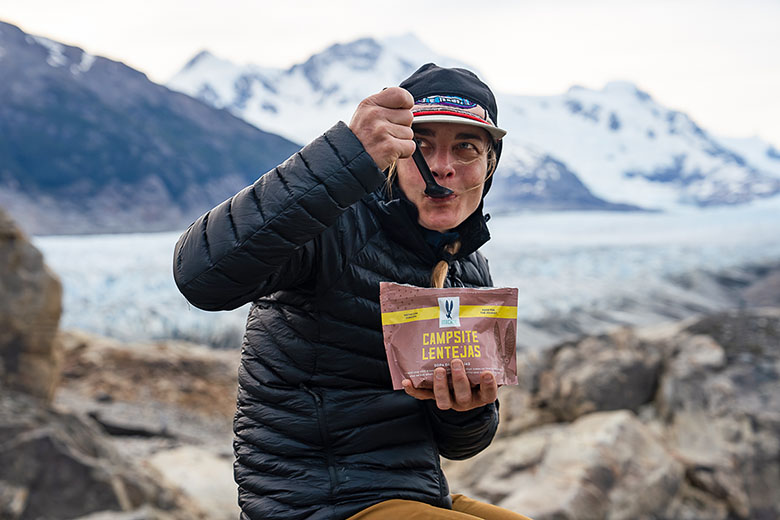
It almost goes without saying: Dinnertime is one of the best parts of any backpacking trip. There’s just nothing quite like warm, filling food after a long day on the trail. We've been eating our way through the market to bring you our favorites since 2020, and in choosing the 19 best backpacking meals of 2025, we put an emphasis on taste, nutritional value, packability, preparation time, and cleanup. In addition, weight, calories, and price certainly matter to most backpackers, so we calculated handy “calories per ounce” and "calories per dollar" specs for each. For more background information, see our comparison table and buying advice below the picks, along with details about our testing process.
Editor's note: We updated this guide on December 19, 2024, to add our favorite meals from various brands that we've sampled recently. We also moved Pinnacle Foods Co up in our rankings and incorporated feedback and photos from a recent testing trip in Wyoming's Wind River Range.
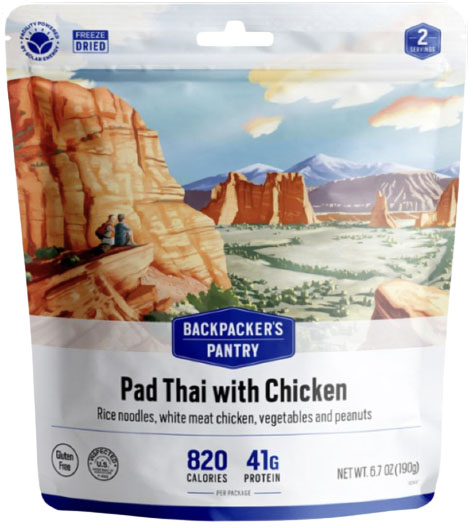 Cooking method: Pouch
Cooking method: Pouch
Average cook time: 15 minutes
Calories per ounce: 118
Our favorite meal: Pad Thai with Chicken
What we like: Great bang for your buck and incredible selection.
What we don’t: Long cook time; other brands have more interesting and/or healthier menus.
Choosing a top pick is never easy, especially when it comes to something as subjective as food. Everyone has their own taste and dietary preferences, caloric needs, and budget, and we’re not here to tell you what to like. What’s more, in 2025, there’s no shortage of incredible mom-and-pop companies serving up delicious and nutritious backcountry meals (don’t worry, we’ll get to these below). All that said, we’ve reserved our best overall pick for a reliable standby that offers a large and diverse menu—including many gluten-free, vegan, and organic options—and great bang for the buck: Backpacker’s Pantry. Their Pad Thai, which comes complete with a small package of peanut butter and a handful of separately packaged peanuts, is one of our all-time favorites. We also enjoyed some of their latest meals, including Drunken Noodles and Pesto Pasta with Chicken, during a spring ski tour on Mount Rainier last year.
If you visit the food aisle of just about any outdoor store, you’ll see Backpacker’s Pantry, Mountain House, and AlpineAire compete for the title of most ubiquitous backcountry meal. All three are reasonably priced and come in flat, packable pouches; offer large serving sizes; and have a plethora of special diet options available. But we think Backpacker’s Pantry meals taste better than the competition, and at 58.5 calories per dollar on average, they offer excellent bang for your buck, too (Mountain House and AlpineAire meals average 49.9 and 48.6 cal/$, respectively). For value alongside great flavors and recognizable ingredients, Backpacker's Pantry puts it all together better than most. And if you're willing to spend up for gourmet, organic, or all-natural menus, check out options like Heather's Choice and Good To-Go below.
See Backpacker's Pantry Meals
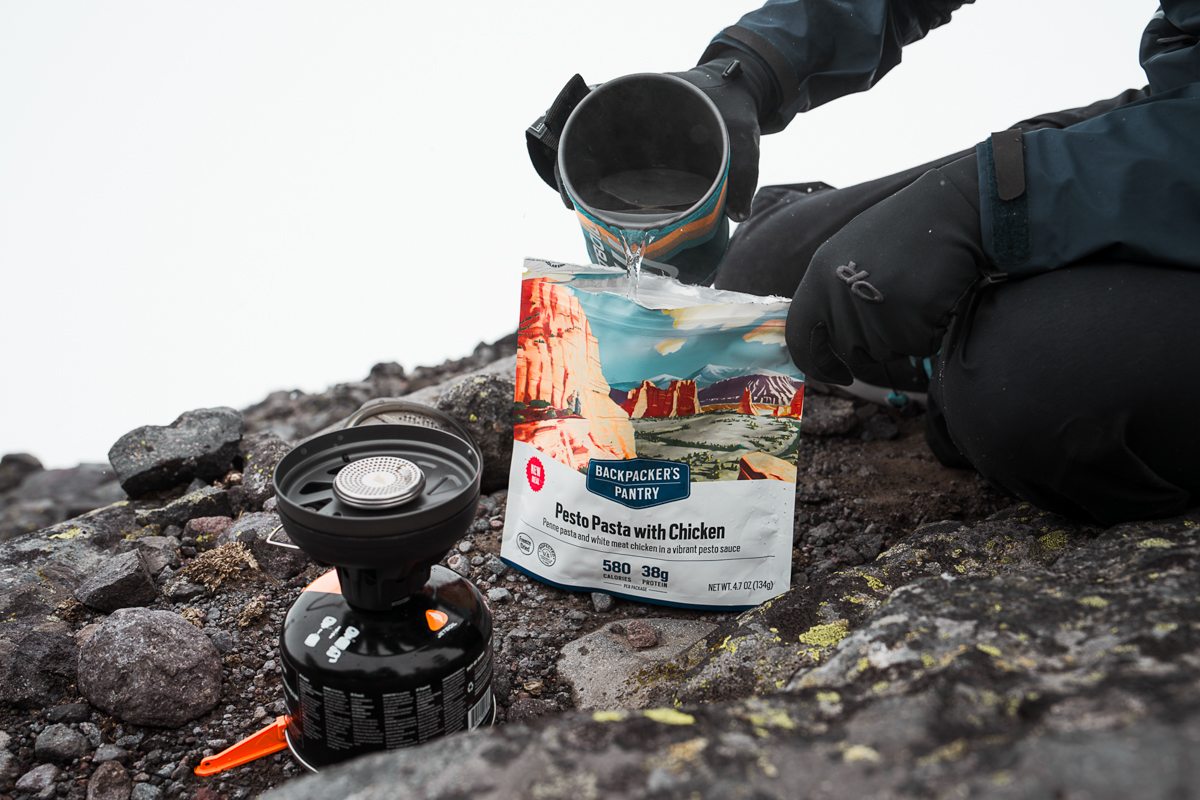
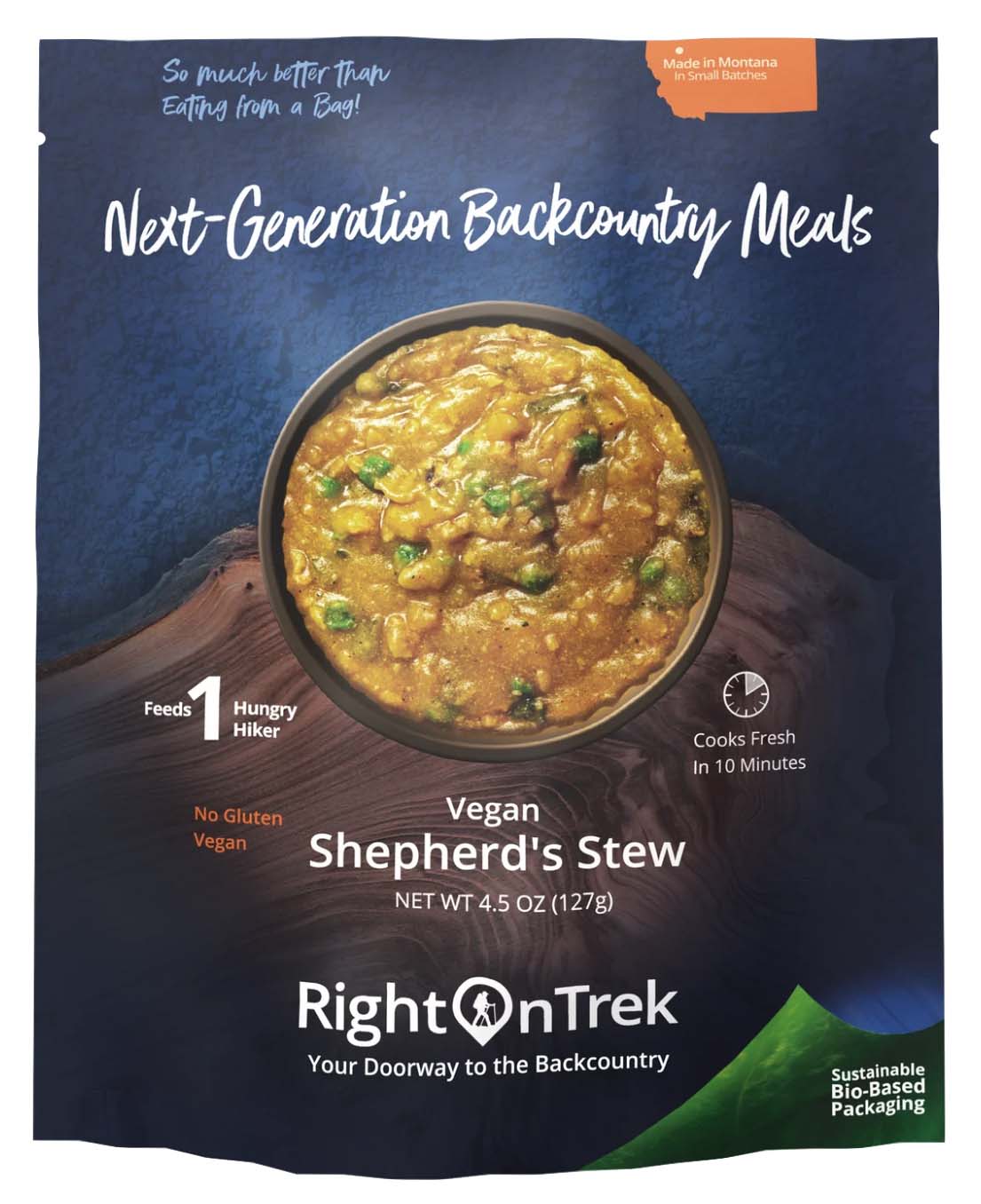 Cooking method: Pot
Cooking method: Pot
Average cook time: 6-12 minutes
Calories per ounce: 120
What we like: Affordable meals and the option of convenient custom meal planning.
What we don’t: You’ll need to dirty a pot.
Food is expensive, and backcountry meals are no exception. For the most affordable option on the market, take a look at RightOnTrek. While their price tags are slightly lower than that of the competition (on average around $10 for single servings and $15 for double), the real kicker here is calorie count. These are legitimate one- and two-serving meals—while many meals that advertise as two-person offerings make a great dinner for one (like those from Firepot below), we’re guessing that most hikers won't be tackling RightOnTrek’s 1,150-calorie two-serving Backcountry Chili on their own. And the numbers don’t lie: In our calorie per dollar metric (listed in the comparison table below), RightOnTrek scores head and shoulders above the rest.
However, RightOnTrek’s meals come with one major caveat: They must be cooked in a pot over a stove, which is a lot less convenient than a just-add-water pouch. Most notably, this method requires dirtying a pot, which will then need to be cleaned before boiling water for coffee or tea (be sure to follow Leave No Trace practices when you dispose of your wastewater). On the other hand, RightOnTrek’s meals are faster to prepare than many of the just-add-water meals here at about 10 minutes from start to finish. But if having to clean a pot is a dealbreaker for you, check out Mountain House and AlpineAire Foods below, both of which have several budget-friendly options.
See RightOnTrek Meals
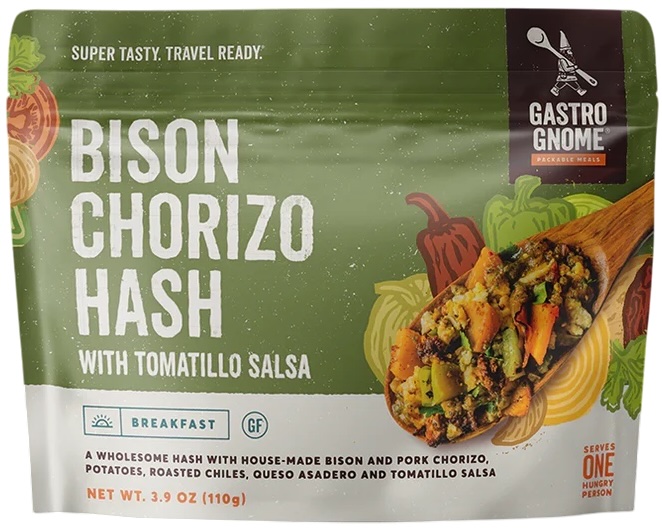 Cooking method: Pouch
Cooking method: Pouch
Average cook time: 8-12 minutes
Calories per ounce: 125
Our favorite meal: Bison Chorizo Hash
What we like: Real ingredients and cooking practices; restaurant-quality flavors.
What we don’t: Pricey; some might want blander meals in the backcountry.
Choosing between various backpacking meal options isn’t too dissimilar to deciding on a restaurant: You’ll factor in price, quality of food, amount of food, and overall experience. And as restaurants vary from fast food joints to fine dining, so too do your backcountry options. Gastro Gnome sits at the top of the food chain, with a small-team operation that uses real ingredients and bonafide cooking practices (including marinating their Indian Yogurt Braised Chicken overnight) to deliver truly top-notch meals. Their menu includes offerings like Almond Pesto and Mushroom Ragu Farfalle and Italian Fennel Sausage Rigatoni—and they actually taste as delicious as they sound.
At 125 calories per ounce, Gastro Gnome’s meals are about mid-pack in terms of caloric density, which is impressive in the gourmet category and makes them a totally viable option for everyone from ultralight thru-hikers to casual backpackers. And unlike most gourmet restaurants, there’s not much of a cost penalty with Gastro Gnome’s meals—they’re pricey at $17 to $18 per dinner, but in 2025, that’s just the high end of normal. You will want to prepare yourself for complex flavors, which not everyone is drawn to in the backcountry (sometimes, we just crave good ol’ mac and cheese). But when sampled alongside other premium meals on a recent backpacking trip, all six members of our testing team concurred: Gastro Gnome’s entrées are something special.
See Gastro Gnome Meals
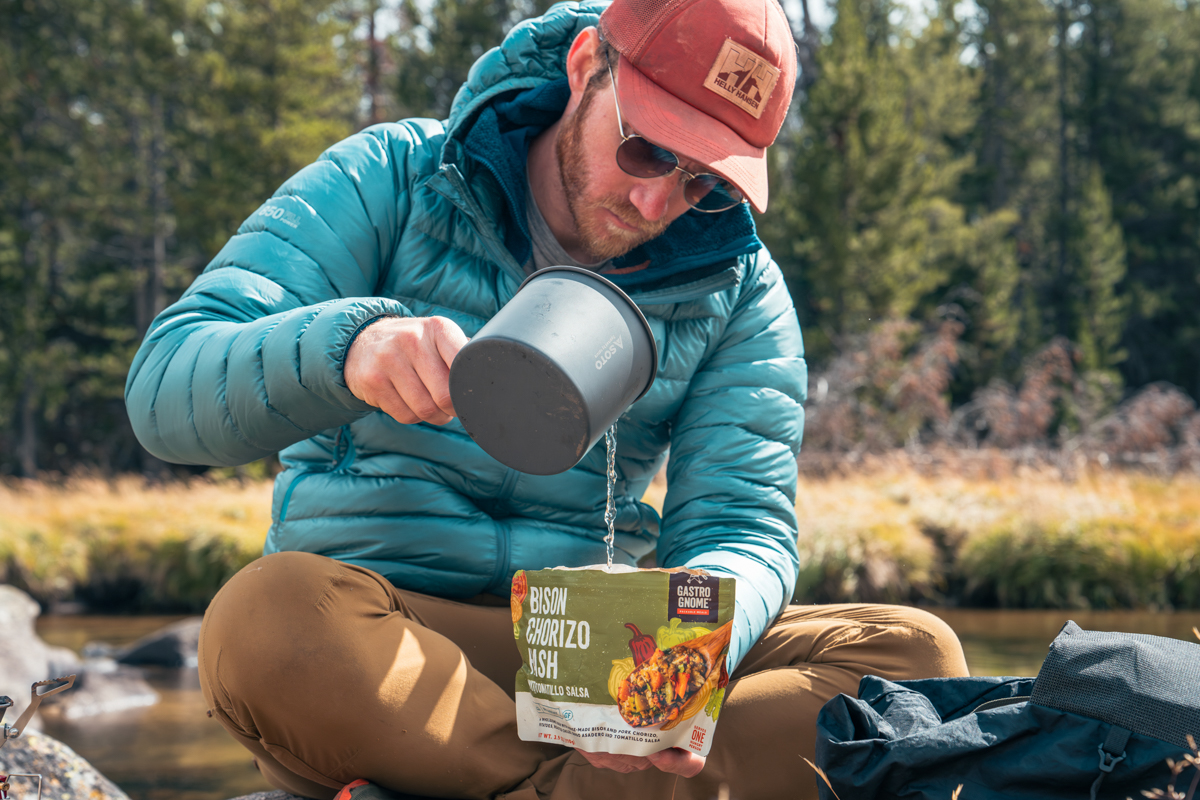
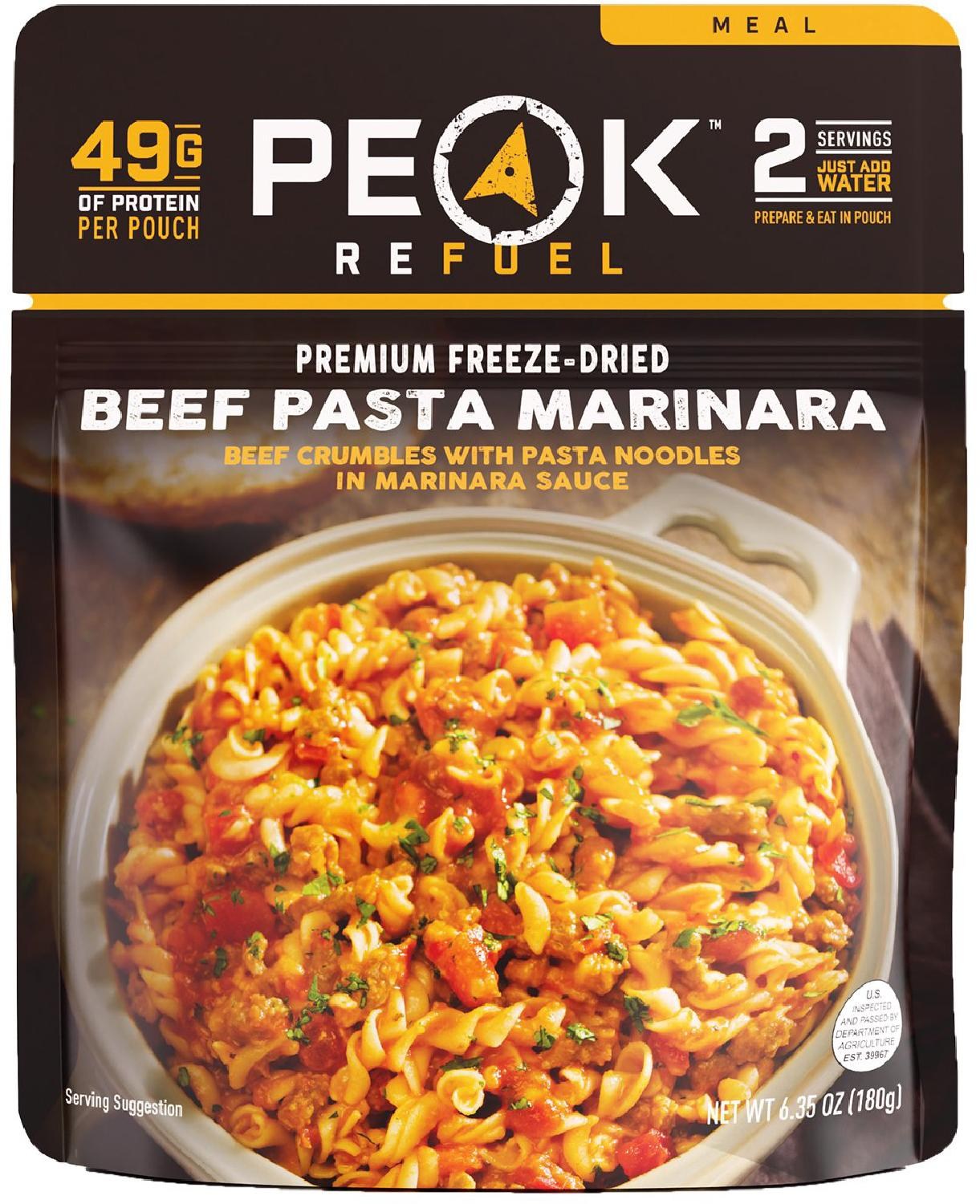 Cooking method: Pouch
Cooking method: Pouch
Average cook time: 10 minutes
Calories per ounce: 163
Our favorite meal: Beef Pasta Marinara
What we like: Packed with calories and protein.
What we don’t: Dishes are noodle-heavy and only come in two-serving pouches.
If you’re trying to keep your pack weight low while maximizing your food supply, Peak Refuel should be at the top of your list. Their dinners pack a serious punch with an average of 163 calories per ounce and one of the highest protein counts of any option on our list (an average of 37.6g per serving). They also use 100% real meat and feature a few vegetarian options, too, including the Butternut Dal Bhat with an impressive 24 grams of protein and 920 calories. Like Mountain House below, Peak Refuel’s entrees are freeze dried and rehydrate in just 10 minutes with less water than dehydrated pouch meals. If you’re looking for an easy and quick way to replenish after a long day outside—we’re looking at you, thru-hikers and climbers—Peak Refuel is a solid choice.
All that said, there are some trade-offs to going with such a power- and calorie-packed option. Unlike companies like Gastro Gnome that prioritize creative and quality ingredient lists, Peak Refuel’s offerings are fairly traditional and noodle-heavy. For better variety, we also like Pinnacle Foods Co below, although their meals are a little less calorie-dense at 152 calories per ounce. Further, we’ve found that Peak Refuel’s double serving sizes aren’t ideal for solo adventures—with close to 1,000 calories per pouch, many hikers will end up sharing or having to save some for later (which can be a process). On the flip side, that means you can have dinner for two for just $14 to $16, which is more affordable than most options here.
See Peak Refuel Meals
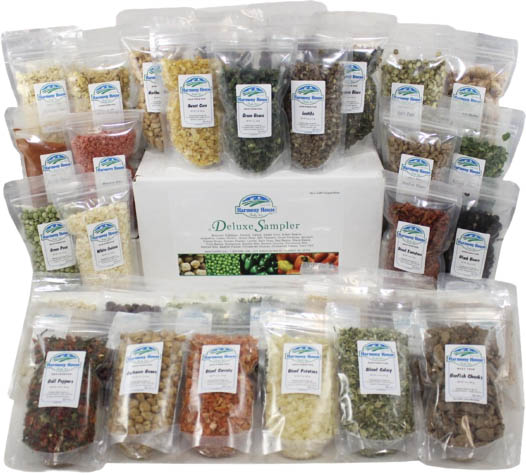 Cooking method: Pouch/pot
Cooking method: Pouch/pot
Average cook time: 10-15 minutes
Calories per ounce: N/A
Our favorite meal: Garden Veggie Chickenish Soup
What we like: Extensive selection of nutritious staples for DIY backcountry meals.
What we don’t: Vegetarian and gluten-free options only.
Harmony House’s website is reminiscent of the bulk foods aisle of your local grocery co-op, with a large assortment of dehydrated and freeze-dried offerings. Ambitious backcountry chefs can stock up on the staples—dried vegetables and beans, meat-flavored TVPs (short for textured vegetable protein), fruits and berries, soup blends, and more—and save a good deal of cash in the process. You can pre-pack your meals at home (Harmony House sells a few different sizes of just-add-water zip pouches) or bring the pantry to the field so you can improvise for each evening’s meal.
Unlike most backcountry food brands, Harmony House does not offer pre-packaged entrées (they do have soup and chili packets), limiting their appeal to seasoned camp chefs or those inclined to DIY. And because Harmony House is completely vegetarian and gluten-free, you won’t find dehydrated meats or many simple carbohydrates, which are an easy way to tack on extra calories and protein in the field. Further, most hikers will simmer these supplemental ingredients in a pot along with instant rice or noodles (easily purchased at your local grocery store), resulting in additional cleanup compared to simple pouch meals. As a final note, know that some of their soup kits come unseasoned, and a lack of careful reading can lead to a very bland meal in the backcountry (speaking from experience). Regardless, if you’re on the trail for long stretches and looking for an affordable yet healthy alternative to pre-packaged dinners, Harmony House is a great place to start.
See Harmony House Foods
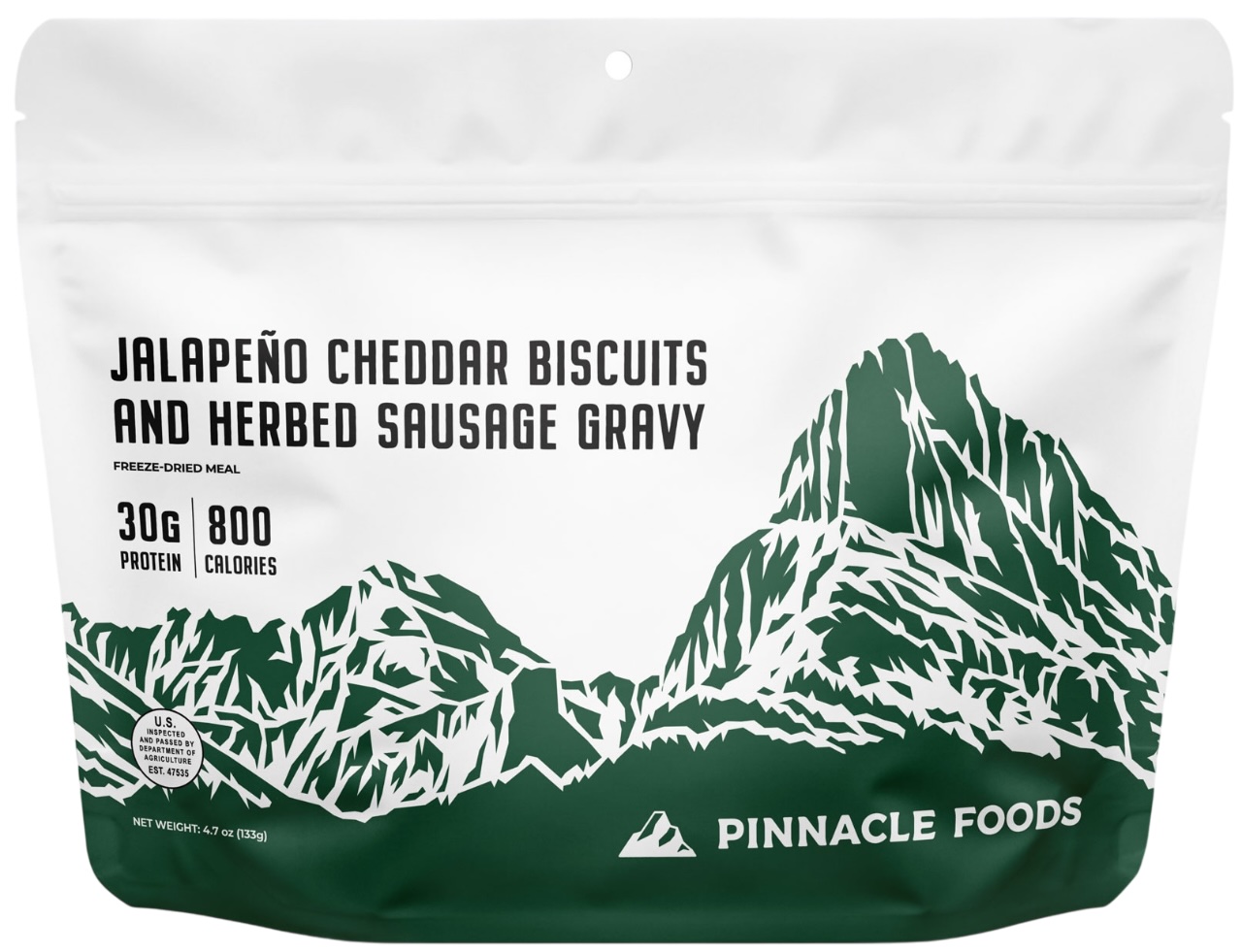 Cooking method: Pouch
Cooking method: Pouch
Average cook time: 12 minutes
Calories per ounce: 152
Our favorite meal: Jalapeño Cheddar Biscuits and Herbed Sausage Gravy
What we like: Calorie-dense meals with real-food ingredients and great flavors.
What we don’t: High in sodium.
Though it's not uncommon for taste to be sacrificed for the sake of nutrition, we appreciate that Pinnacle Foods strikes a nice balance between the two. This small but mighty High Point, North Carolina-based brand uses fresh and natural ingredients to create high-powered entrees with impressive caloric density (152 calories per ounce on average). We’ve taken Pinnacle meals along on many backcountry outings and have yet to be disappointed: Their Jalapeño Cheddar Biscuits and Herbed Sausage Gravy is among our all-time favorites, and the Italian Sausage and Zesty Tomato Sauce with Farfalle Pasta is just what you want after a long day out. In our experience, Pinnacle offers more palate-pleasing meals than Peak Refuel above while still managing to pack a lot of nutrition into a lightweight package.
Our one gripe with Pinnacle’s offerings is their high sodium content, which hovers around 50 to 70% of your daily value for each meal. But for Pinnacle Foods’ target audience, this could actually be a strong suit. They also give you the option between standard (Retort) and omnidegradable pouches, the latter of which have a shorter best-buy date but are actually compostable (we’re seeing these used more and more in backpacking meals of late). All told, you’d be hard-pressed to find another company that offers the same combination of great flavors, real-food ingredients, and caloric density—we’re always happy packing a Pinnacle Foods pouch in our pack knowing that it’s going to be a tasty and satiating meal.
See Pinnacle Foods Co Meals
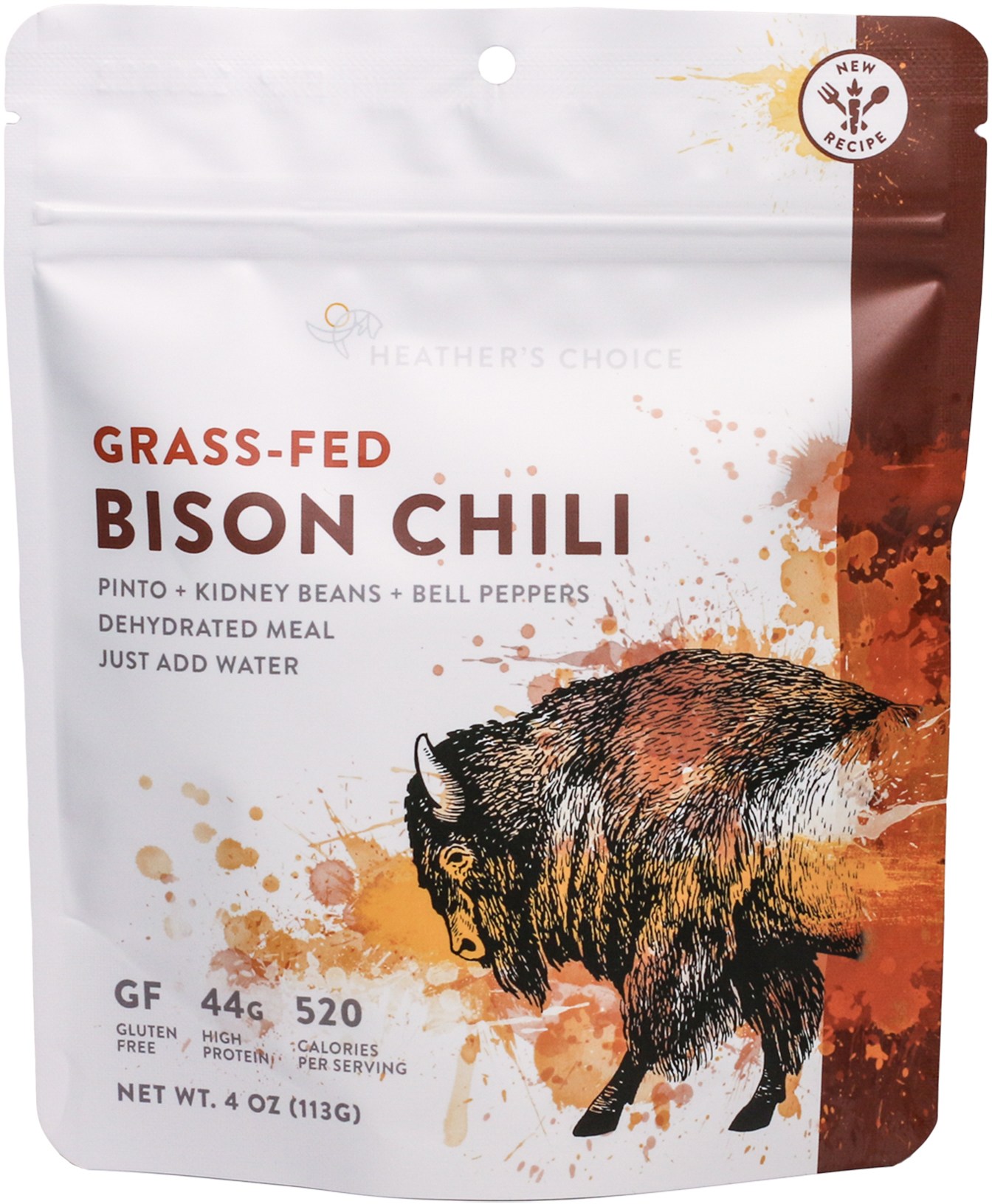 Cooking method: Pouch
Cooking method: Pouch
Average cook time: 20 minutes
Calories per ounce: 129
Our favorite meal: Grass-Fed Bison Chili
What we like: Ethically sourced food that tastes really good.
What we don’t: Expensive; not a ton of options.
After dehydrating her own backcountry food for years, Alaska-based Heather Feather launched Heather’s Choice via a Kickstarter campaign in 2015. Now, this small and growing company is one of our favorite choices when it comes to taste, ingredients, and gluten-free options. Heather takes care in putting together her meals, using high-powered foods such as coconut, maple syrup, wild-caught Alaskan Sockeye salmon, and 100%-grass-fed bison and elk. Impressively, many of the dinner options contain a whopping 35 to 40 grams of protein per serving and average out to 129 calories per ounce. And the cherry on top: Each meal comes in an impressively tiny package (kudos to Heather for conserving materials), which is great for small packs and spoons alike.
You don’t get a ton of options with Heather’s Choice, especially if you’re a vegetarian (although each dinner is gluten, soy, egg, and dairy-free). Further, the one-serving meals will run you as much as $17, and at around 500 calories per entrée, you get a lot less bang for your buck than with Backpacker's Pantry above (31.4 calories per dollar vs. 58.5). But Heather’s Choice is some of the best-tasting and well-sourced backpacking food around, and the trade-offs could be well worth it for those who don’t want to compromise enjoyment or nutrition while on the trail. And to complete your kit, we also recommend looking at Heather’s Choice’s breakfast options (such as the Morning Glory Oatmeal for $9) and her popular cookie-like Packaroons, which offer 170 calories of healthy fats and sugars in a 1-ounce package.
See Heather's Choice Meals
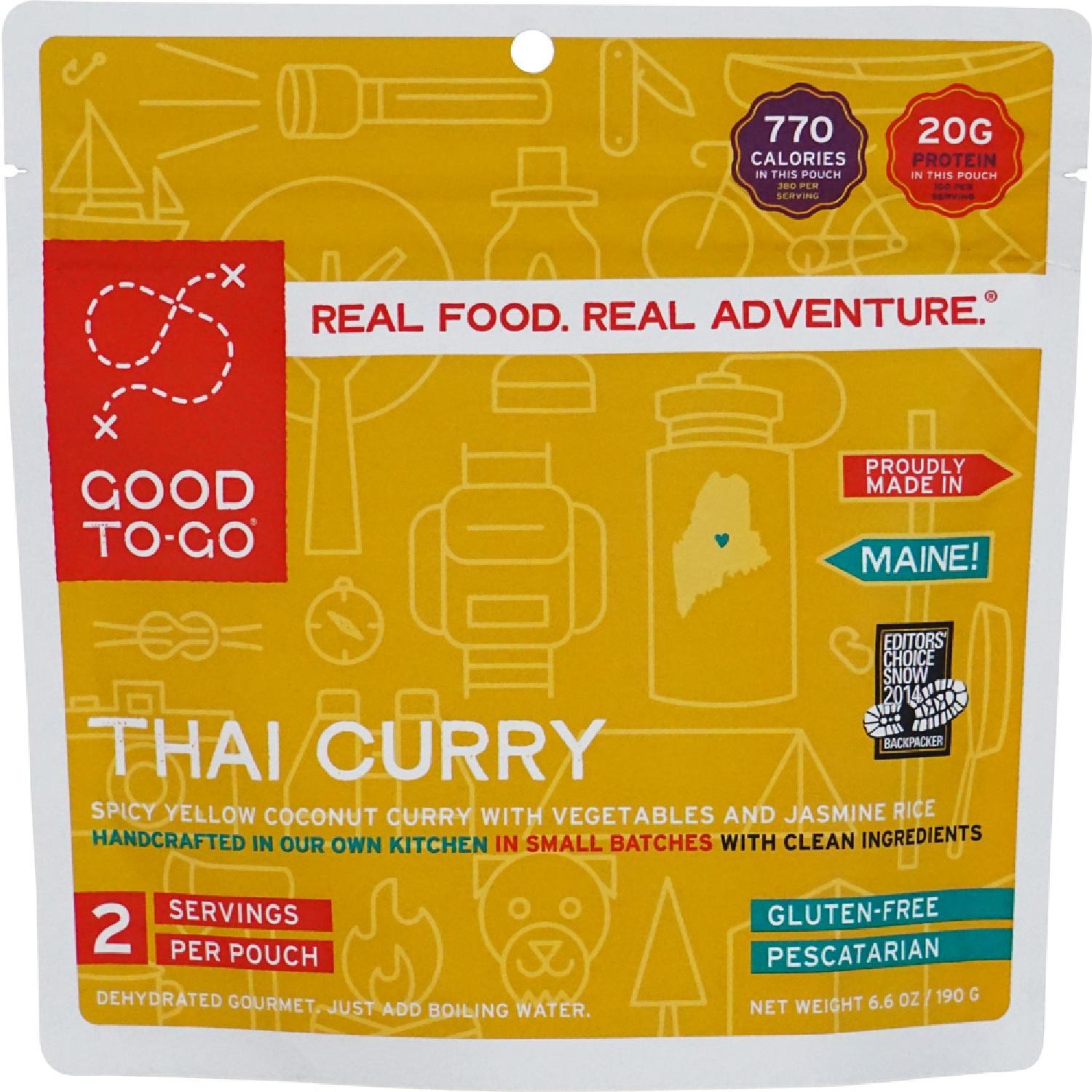 Cooking method: Pouch
Cooking method: Pouch
Average cook time: 15-20 minutes
Calories per ounce: 118
Our favorite meal: Thai Curry
What we like: Great flavors and healthy, real ingredients.
What we don’t: Can be too spicy; slower to cook than many of the options below.
Good To-Go spearheaded the current generation of backpacking meals, which prioritizes the same whole foods and fresh flavors that many of us eat at home. Designed by professional chef Jennifer Scism, the assortment of all-natural, gluten-free meals have an ingredient list that is short and readable (translation: real food). Their volume of offerings can’t match some of the other big-name brands here—Good To-Go has 14 dinner options to date—but the combination of flavor, quality ingredients, and calorie-to-weight ratio earns this Maine-based company our resounding endorsement.
Good To-Go falls about mid-pack in both our calories per ounce and calories per dollar metric, although their meals are more affordable than much of the gourmet competition. That said, we’ve noticed ourselves reaching for Good To-Go less and less as the market expands: Their flavors can be rather harsh at times (on more than one occasion, the Thai Curry has been too spicy for us to finish), and the meals aren’t as tasty as those from brands like Gastro Gnome and Heather’s Choice. Further, their 20-minute cook time is one of the longest here. But if you’re gluten-free (or even celiac) or want to eat healthy backcountry meals without deviating too far from the mainstream, it's hard to beat Good To-Go’s combination of quality ingredients, price, and selection.
See Good To-Go Meals
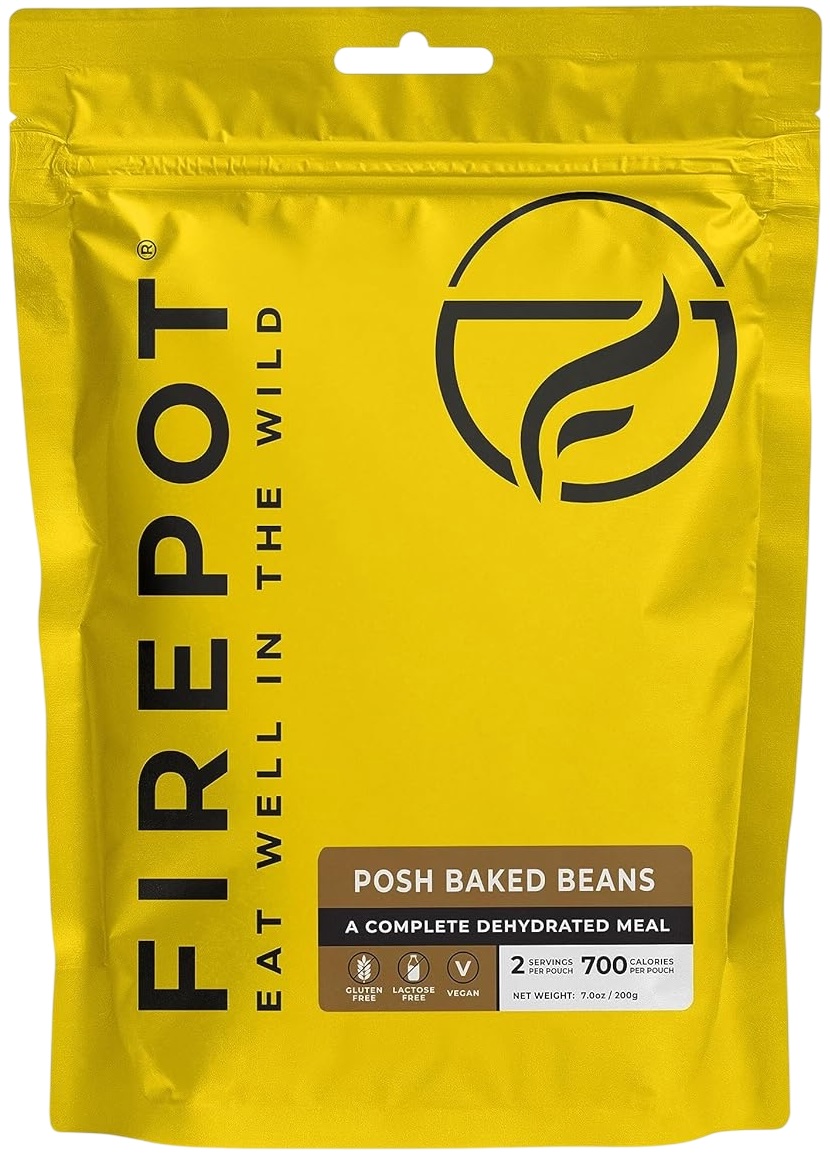 Cooking method: Pouch
Cooking method: Pouch
Average cook time: 15 minutes
Calories per ounce: 114
Our favorite meal: Posh Baked Beans
What we like: Well-sourced and delicious meals; more affordable than Gastro Gnome and Heather’s Choice.
What we don’t: Not as calorie-dense as Gastro Gnome's meals.
Founded in the rural southwest of England, Firepot is fresh on the scene in the U.S., now being sold through outdoor giant REI. We tested a number of their meals on a recent backpacking trip in Patagonia and were very impressed with what the small startup has put together. Their entrées represent a positive shift in backcountry cuisine that we’re all excited about: a focus on whole, natural ingredients and thoughtful flavors. Sourcing many of their ingredients from the rural area around their headquarters, Firepot’s meals are some of the best we’ve tasted and include a number of vegan and gluten-free options as well.
Firepot goes head-to-head with Gastro Gnome as one of the best-sourced and healthiest meals here. At 114 calories per ounce, it’s not quite as power-packed as Gastro Gnome, which might be a consideration for those particularly concerned about keeping pack weight low. But you do get a lot of calories per pouch—ours averaged about 770 calories per meal—which results in a better value overall (especially if you’re sharing your meal or like a healthy amount of food). All in all, Firepot is a great brand to have on your radar, and if you order from their website (a bit tricky from the States), you get the option of compostable packaging, too.
See Firepot Meals
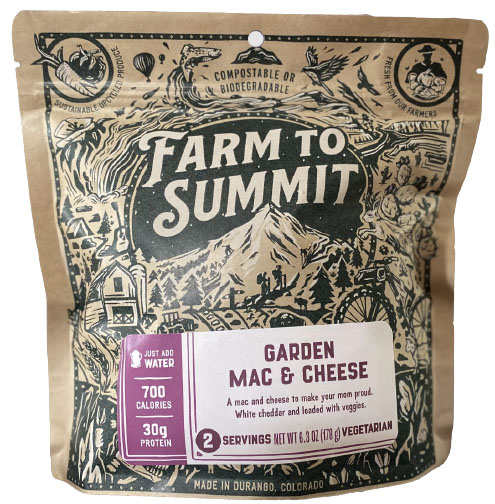 Cooking method: Pouch
Cooking method: Pouch
Average cook time: 15-20 minutes
Calories per ounce: 118
Our favorite meal: Garden Mac & Cheese
What we like: Upcycled imperfect produce; vegan, vegetarian, and GF options.
What we don’t: Flavors are hit or miss; average in terms of caloric density.
Farm to Summit joins the ranks of gourmet backpacking meals, with a small assortment of vegetarian, vegan, and gluten-free entrées made in small batches with real food. As their name states, Farm to Summit sources many of their ingredients directly from farms and focuses especially on “imperfect” produce: fruits and vegetables that are rejected by grocery stores due to deformities, scars, or being overly ripe (in 2022, 32% of the produce in Farm to Summit’s meals was imperfect and would have otherwise gone to waste). At the time of publishing, they offer nine unique entrées, ranging from Thai Red Curry to Wild Mushroom Pot Pie.
Unfortunately, we've found Farm to Summit meals to be pretty hit or miss in recent testing. For instance, we love their Garden Mac & Cheese, but the Harvest Green Curry tasted processed and perfumed. And while their meals are great for those who prioritize healthy eating and natural ingredients in the backcountry, their veggie-forward menu might come up short for those wanting to pack in the calories. However, they’re nevertheless a great meatless option that’s priced a bit lower than much of the gourmet competition, and you can still get your protein with entrées like the Three Bean Chili & Cornbread (39g of protein). Finally, it’s also worth mentioning Farm to Summit’s powdered latte mixes—including the Golden Milk Latte, Whole Milk Latte, Chili Mocha Latte, and Double Shot Latte—which come in single-serving packets and are a luxurious replacement for black coffee (just make sure you mix them really well—we’ve been turned off by powdered chunks).
See Farm to Summit Meals
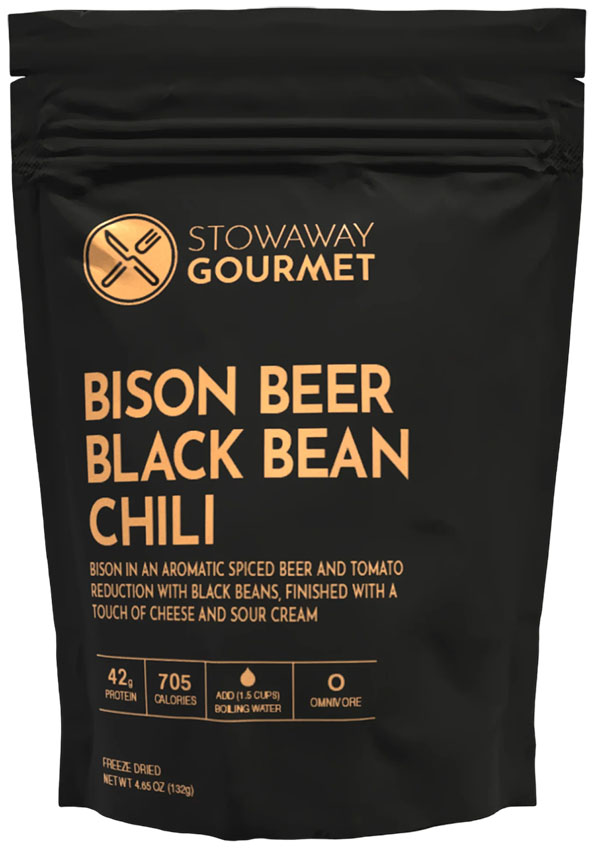 Cooking method: Pouch
Cooking method: Pouch
Average cook time: 10-15 minutes
Calories per ounce: 152
Our favorite meal: Bison Beer Black Bean Chili
What we like: La crème de la crème of backcountry meals.
What we don’t: Expensive.
If you’re looking for la crème de la crème of backcountry meals, check out Stowaway Gourmet. With entrée names like Bison Beer Black Bean Chili and La Pasta Nostra, you might even think you’ve stepped off the trail and into a gourmet restaurant. And the hype is real: We’ve tested a number of Stowaway’s offerings (including their breakfasts), and they taste just as good as the descriptions would suggest. They’re also packed with calories (tying for third place with Pinnacle Foods in terms of calories per ounce), making them a viable option for hikers concerned about keeping their pack weight low.
This might be a controversial opinion, but we found Stowaway Gourmet’s meals to be almost too tasty for the backcountry. Hear us out: Stowaway's flavors are fairly complex, which can provide an interesting dissonance when the food is rehydrated mush eaten out of a plastic bag. In other words, adventurous eaters may very well find plenty to like, but those who struggle with backcountry nutrition might want to stick with more traditional options from brands like Backpacker’s Pantry or Good To-Go. These meals are also the most expensive on our list, ranging from $18 to $20 for many of their meat-based options, like the venison-based Comrade Doeganoff (averaging 32.7 cal/$ versus 42.3 for Gastro Gnome). We'll leave it up to you to decide, but Stowaway certainly has the gourmet side of the market covered.
See Stowaway Gourmet Meals
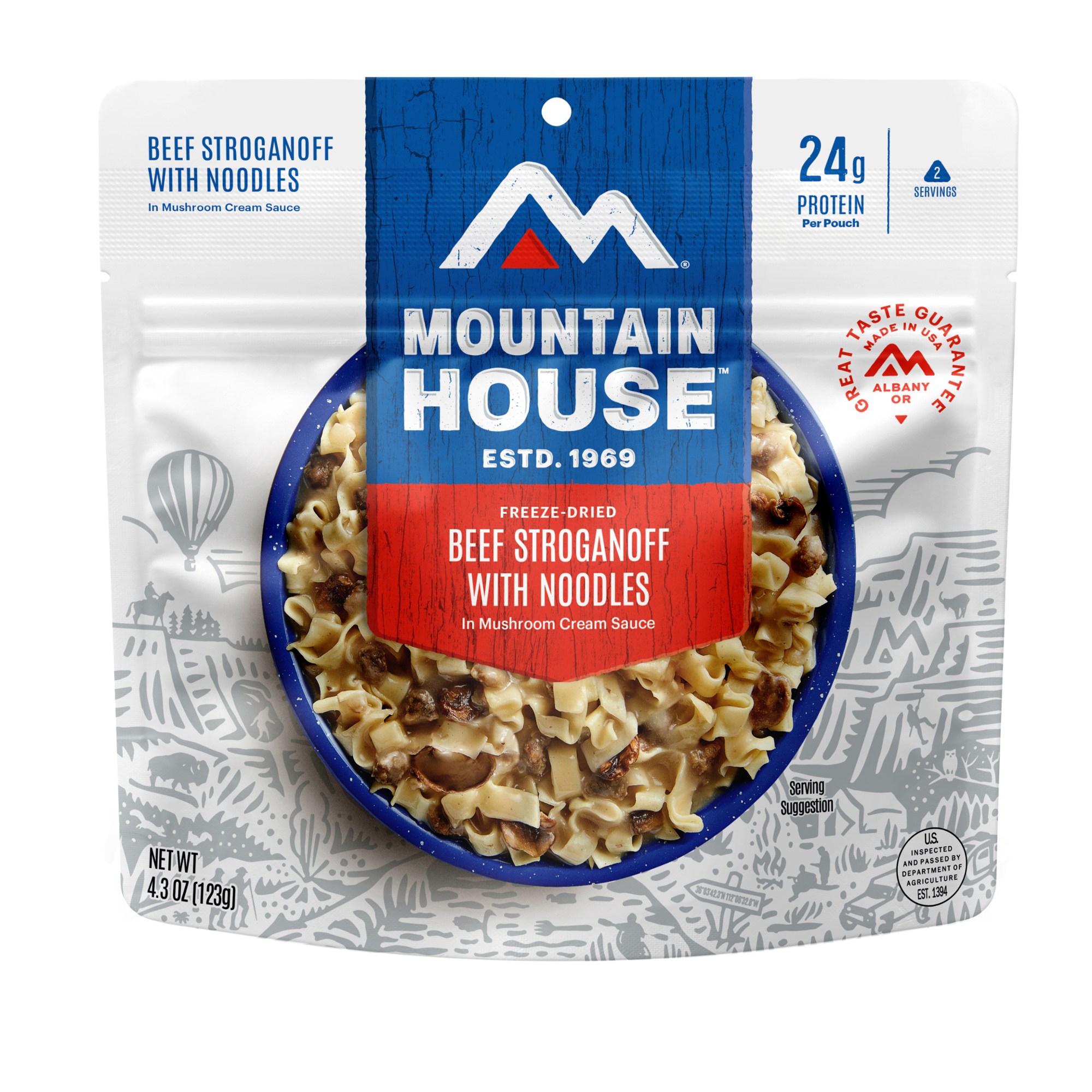 Cooking method: Pouch
Cooking method: Pouch
Average cook time: 9-15 minutes
Calories per ounce: 134
Our favorite meal: Chicken Fajita Bowl
What we like: A classic value choice with decent taste and high caloric density.
What we don’t: Lots of preservatives and sodium.
The Mountain House name is practically synonymous with freeze-dried food, and for good reason. They may not knock it out of the park in terms of taste, but these meals remain a reliable and lightweight standard for backcountry cuisine. Mountain House’s home-cooked-style dinners—like Chicken and Dumplings and Chili Mac with Beef—cook up quickly (most are ready to eat in 9 min.) and are great for filling up after a long day on the trail. Importantly, you also get good bang for your buck with a price that undercuts similar two-serving options by around $4 to $5, as well as a high calorie-to-weight ratio. Plus, all Mountain House meals come with a 30-year Taste Guarantee, so you can buy now and eat much, much later.
Mountain House has been dishing up backcountry meals for over 50 years, but the competition has never been fiercer. Unlike many of the modern gourmet options, you won’t find all-natural or organic ingredients here, and those with special diets should look elsewhere. In addition, the pasta-heavy menu hasn’t changed much in years, and each entrée is startlingly high in sodium (which can be a good thing, depending on your needs). And while Mountain House is a relatively affordable standby, Backpacker’s Pantry wins out in terms of calories per dollar. In other words, we think there are a number of better options, but we certainly won’t fault you for sticking with an old classic. It’s also worth noting Mountain House’s Pro-Pak lineup, which come in low-profile, single-serving pouches and are generally very high in protein.
See Mountain House Meals
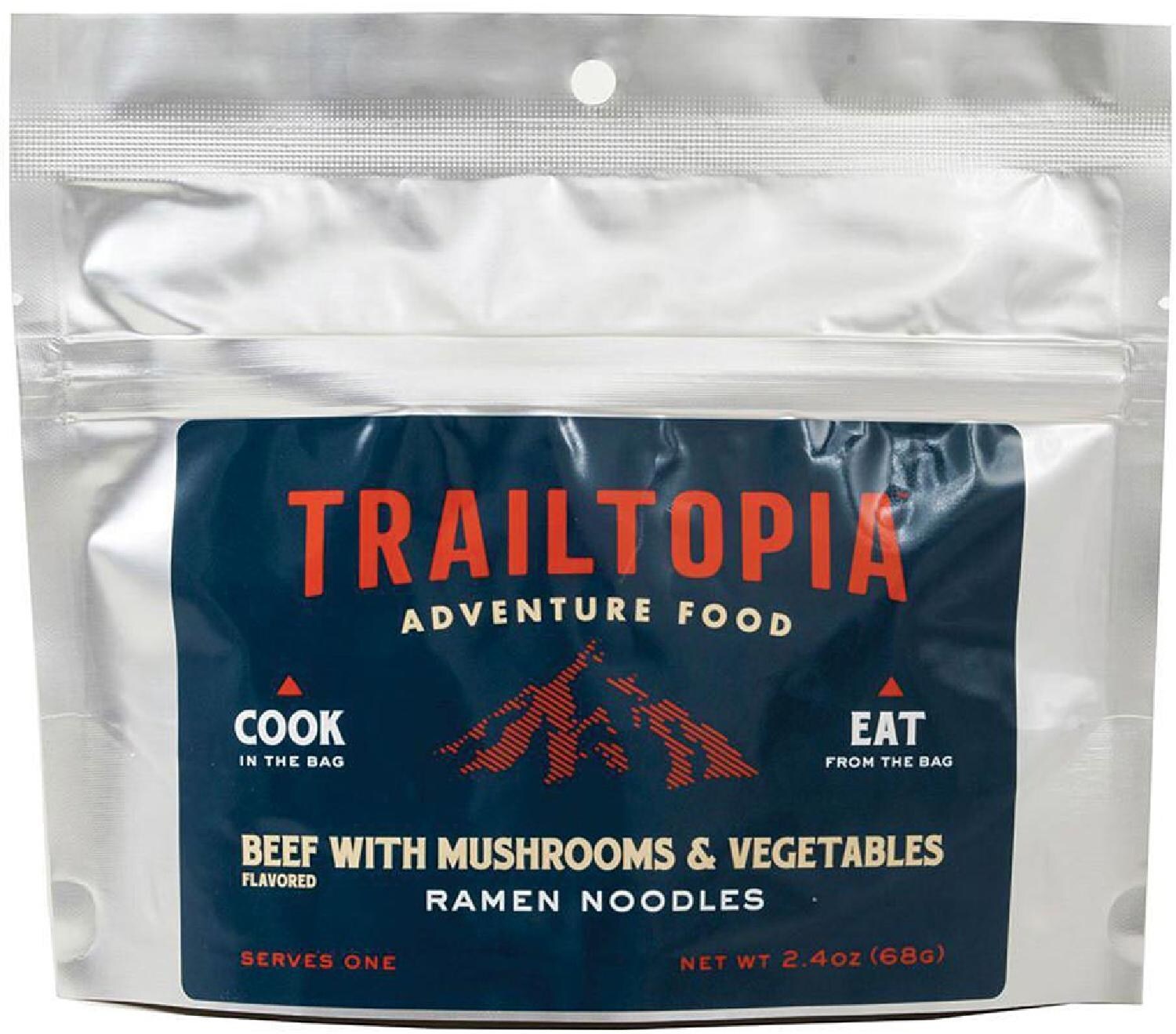 Cooking method: Pouch
Cooking method: Pouch
Average cook time: 8-15 minutes
Calories per ounce: 104
What we like: Quality ingredients and convenient packaging.
What we don’t: Doesn’t stand out in any other way.
Like entrées from brands such as Good To-Go and Heather’s Choice, Trailtopia’s ingredient lists are chock-full of all-natural foods with few chemicals or preservatives. Take their Cajun Smack Chicken & Rice, for example, which is similar to a meal you might have at home with long-grain rice, chicken, onion, broccoli, bell pepper, and spices. We’re also big fans of their short and stout packaging (you won’t have to go fishing with your spoon), and sample packs allow you to try out multiple meals at a discount before committing to full serving sizes. Finally, entrées are packaged to feed two (some single servings are available), and you can also pick up meat “side packs” to add extra protein.
There’s no denying that Trailtopia’s meals are healthy and taste good, which is great news at the end of a long day of hiking. What's more, at 59.1 calories per dollar, they offer fairly good value among the competition. That said, the menu is pretty standard and uninspiring, and you can pack in more calories at a lower weight with brands like Pinnacle Foods and Peak Refuel above. But small gripes aside, we’ve enjoyed digging into many a Trailtopia meal, and they get our wholehearted recommendation for those looking for real trail food.
See Trailtopia Adventure Food Meals
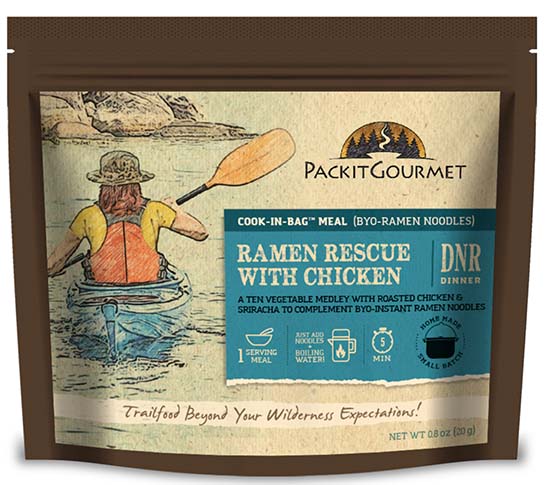 Cooking method: Pouch
Cooking method: Pouch
Average cook time: 10-20 minutes
Calories per ounce: 115
What we like: Tasty food with all the accoutrements.
What we don’t: Pricey for what you get.
Packit Gourmet isn’t quite a household name, but the small online marketplace boasts an impressively diverse lineup including prepackaged meals, bulk dried ingredients, individually packaged sauces, and even separate Cook-in-Bags for DIY dehydrated food. They offer around 20 different tasty dinners (with a variety of options for special dietary needs) that are more flavorful than most of the competition. And Packit sweats the details, too: For example, their Austintacious Tortilla Soup comes with a packet of lime powder, dehydrated jack cheese, and tortilla chips.
But Packit meals don’t offer a particularly great bang for your buck—many of their one-serving meals have less than 400 calories yet still cost $13 to $15, which is one of the worst values here. Some also require you to pack your own ingredients—like the Big’un Burrito with Fajita Chicken, which is BYO tortilla. Finally, the shelf life for most entrées is relatively short—only about a year and a half. But for those looking for smaller serving sizes and more creative options than the standard Thai curry or mac ‘n cheese, Packit's unique, flavorful dishes are worth a shot.
See Packit Gourmet Meals
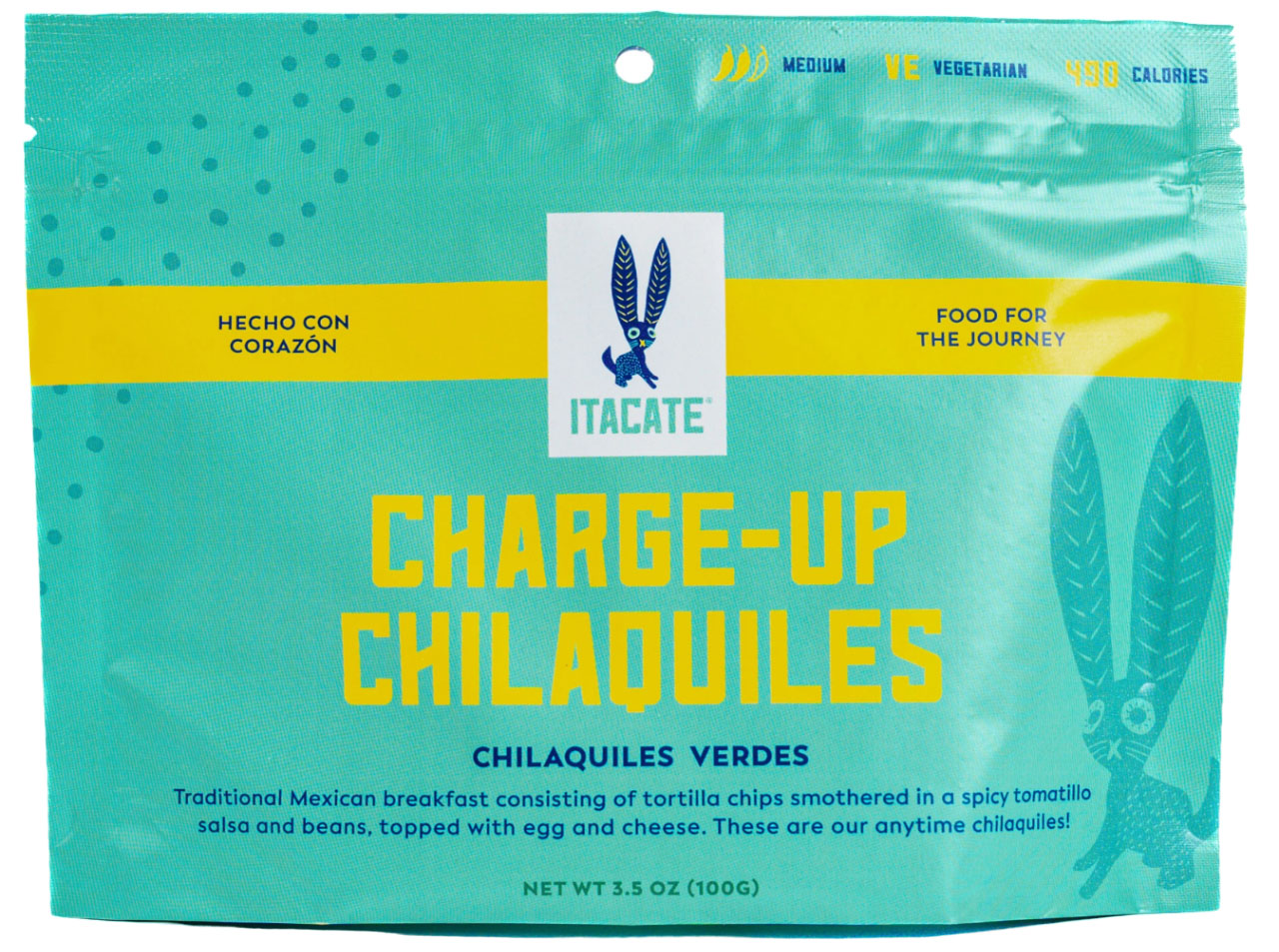 Cooking method: Pouch
Cooking method: Pouch
Average cook time: 5-10 minutes
Calories per ounce: 128
What we like: Tasty Mexican entrées that help promote diversity and inclusion in the outdoors.
What we don’t: Very limited options.
Up until recently, backcountry-goers have had a fairly limited menu to choose from, consisting mostly of American (or American-adapted) dishes like mac and cheese, beef stroganoff, and chicken and rice. But in the past few years, many cottage brands have stepped up to fill in the gaps, and one of the most exciting new entries is Itacate. Built by a Latinx woman with the goal of bringing Mexican comfort food to the outdoors, Itacate is getting their start with a small selection of entrées, including chilaquiles, caldo tlalpeño (a chipotle-based soup), and a lentil soup.
Itacate comes from the Nahuatl word Itacatl, which refers to the food you take on a journey. We’re excited to see Itacate providing a feels-like-home option for Latinx trail-goers, and they’re also a tasty pick for anyone looking for vegan and vegetarian backcountry food. It's also worth checking out their highly praised Aventura Arroz con Leche breakfast, which consists of fruit, chia seeds, and cinnamon. You’ll pay a bit of a premium for their meals, and the three entrée options are only available in single-serving varieties (each with 490 calories), but we love supporting small brands—especially those that promote diversity in the outdoors.
See Itacate Meals
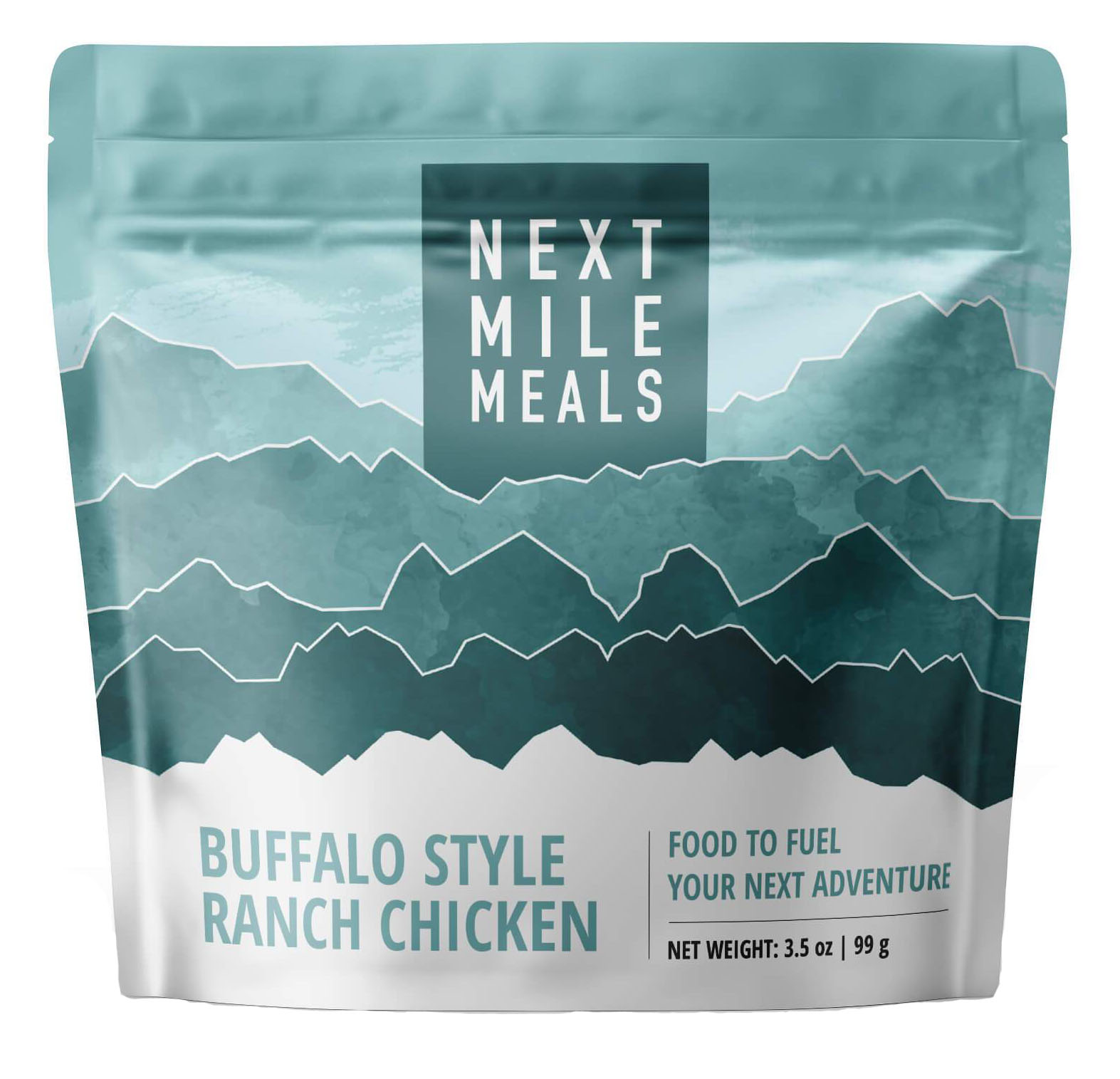 Cooking method: Pouch
Cooking method: Pouch
Average cook time: 7-10 minutes
Calories per ounce: 155
What we like: Incredibly nutrient-dense and generous serving sizes.
What we don’t: Expensive and limited offerings.
Next Mile Meals is a small company that hasn't been around for long, but we took their meals on a trek in Chile’s Parque Patagonia and came away very impressed with the flavors, ingredients, and quick cook time. Like Gastro Gnome above, Next Mile Meals actually taste like real food, which shouldn’t come as much of a surprise after looking at the ingredient labels. These ketogenic entrées cut the carbs and pack in calorie- and nutrient-dense foods like meat, veggies, and cheese. It all adds up to an impressive 155 calories per ounce on average, which is one of the best calories-per-weight specs here.
Our main gripe about Next Mile is the price: $16 only gets you a one-serving pouch, and at only 34.5 calories per dollar on average, they’re far from a standout value (for reference, Peak Refuel's meals offer almost twice the calories per dollar). You also don’t get many entrée choices—seven at the time of publishing—but we expect more over time. Finally, Next Mile Meals are best within a year of purchase, and the included condiments have a short 180-day shelf life. But they’re a great option in terms of caloric density, and it certainly doesn’t hurt that Next Mile Meals are also all-natural and taste great.
See Next Mile Meals
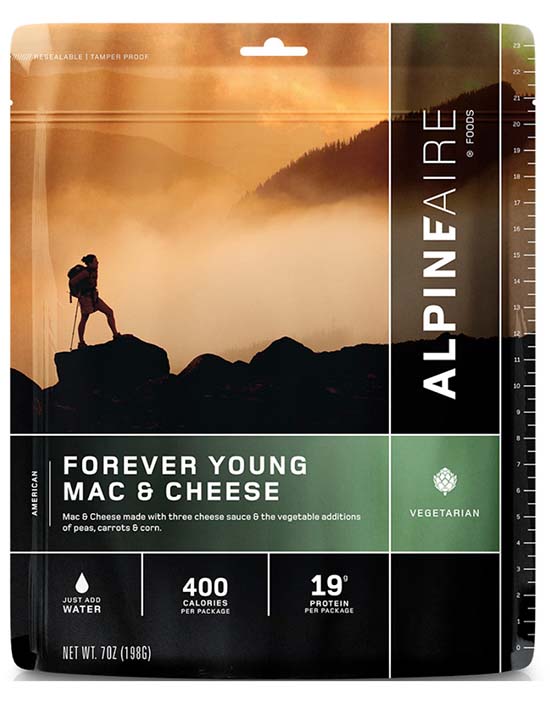 Cooking method: Pouch
Cooking method: Pouch
Average cook time: 10-12 minutes
Calories per ounce: 118
What we like: Low price and fun menu items.
What we don’t: Tastes like standard backpacking fare.
We’ll start by saying that AlpineAire meals sound delicious. With names like Al Pastor with Cilantro Lime Rice, Cheese Enchilada Ranchero, and Chilaquiles Verdes with Carnitas, you practically feel like you’re ordering from a restaurant. They also offer a plethora of special diet options: low-sodium, vegetarian, vegan, gluten-free, cholesterol-free, and all-natural. And their eye-catching packaging clearly displays information on ingredients, serving size, and nutrition. The pouches are flat and packable, and the main courses are as speedy to cook as Mountain House meals. With a relatively low price, AlpineAire seems like the whole package.
Unfortunately, the taste of AlpineAire meals just doesn’t measure up. Perhaps their names and labeling create overly high expectations, or maybe mixing healthy ingredients with a short cook time stresses the flavors. Whatever it may be, we find that AlpineAire dinners are either noticeably bland or so over-spiced that they are hard to finish. If you find one you like, stick with it. Otherwise, the pouch meals above are both tastier and more calorically dense.
See AlpineAire Foods Meals
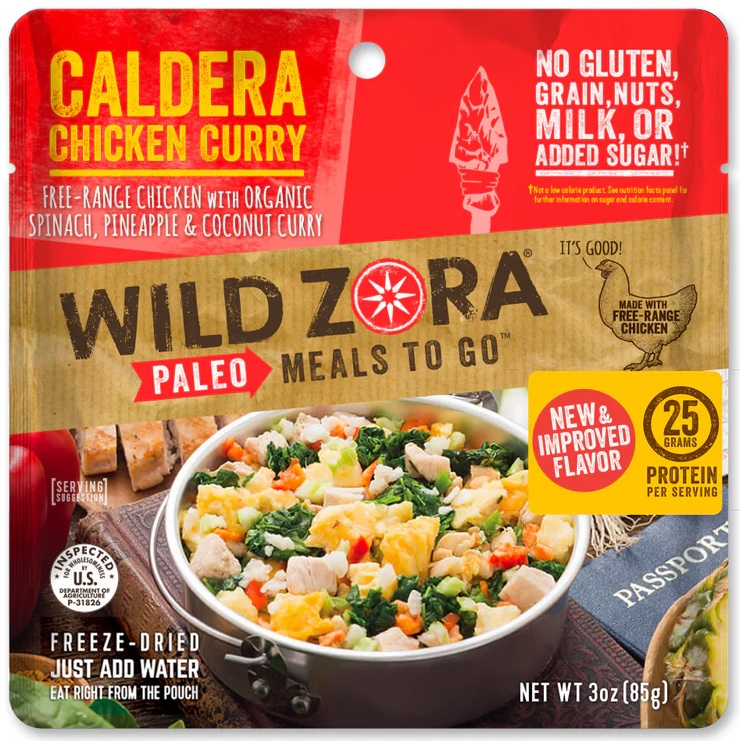 Cooking method: Pouch
Cooking method: Pouch
Average cook time: 5-15 minutes
Calories per ounce: 122
What we like: Incredibly nutrient dense.
What we don’t: Steep price tag of $14 for a single serving.
In a world of noodle-heavy backcountry meals, Wild Zora's gluten-free and protein-rich Paleo Meals To Go are refreshing, and you don’t have to be paleo to enjoy them. The Mountain Beef Stew pouch we tried had an impressively natural ingredient list: beef, vegetables, spices, and sea salt. The meat (free-range, grass-fed, and 100% natural) especially stood out—it retained the taste and texture of real meat better than other freeze-dried meats we’ve eaten. And Wild Zora now offers Quinoa Bowls, too, which also have an impressive ingredient list and come in both meaty and vegan options.
But Paleo Meals To Go come at a high price: $14 for one serving, to be exact. For that cost, you could have three servings of Backpacker's Pantry. They’re also available in less varieties than before—we can only find three dinners (excluding quinoa bowls) on their website at the time of publishing. But the nutrition is hard to beat: For one serving of Mountain House Beef Stew, you’ll get 15% of your recommended daily Vitamin A, 15% of Vitamin C, and 8% of Iron, while one serving of Paleo Meals To Go’s Beef Stew Pouch is packed with 320%, 45%, and 35%, respectively. That’s a huge selling point for those who are focused on getting more than just calories from their backcountry meals.
See Wild Zora Paleo Meals To Go
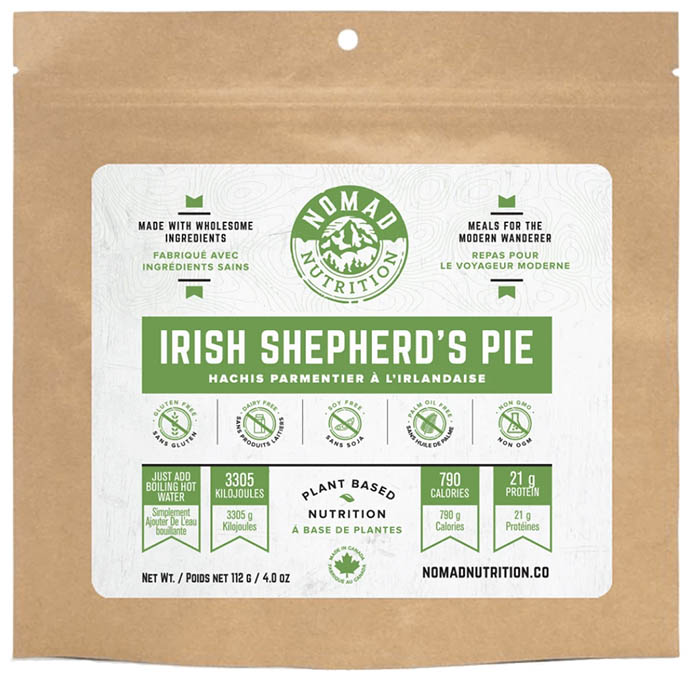 Cooking method: Pouch
Cooking method: Pouch
Average cook time: 12-15 minutes
Calories per ounce: 145
What we like: Unique dehydrating process and surprisingly calorie- and protein-packed.
What we don’t: Limited selection and not the best value.
A small company founded by an adventurous foodie from British Columbia, Nomad Nutrition offers nutrient-dense meals with a strong emphasis on whole food ingredients. And despite being mostly plant-based and 100% gluten- and dairy-free, Nomad’s entrées are startlingly calorie- and protein-packed, scoring comparatively high on our list with an impressive 145 calories per ounce and 15 grams or more of protein per packet. And Nomad is doing things differently with their unique dehydrating process called REVdry, which cuts out the need for preservatives and keeps the ingredient list both natural and low in sodium (a rarity among the competition).
Compared to Peak Refuel above, Nomad Nutrition’s meals have less calories per ounce, although they manage to pull it off without a single noodle-based dish. But while two hungry hikers can get away with sharing a Peak Refuel pouch, Nomad’s similarly priced meals will likely only feed one (they average about 600 calories per pouch), making them the pricier option by a sizable margin. For some it might be worth it: Looking inside a Nomad Nutrition pouch is a clean-eater’s dream, with a colorful rainbow of real food such as potatoes, broccoli, peppers, corn, peas, and more. All told, the company is off to a promising start, and we’re excited to see where they’re headed.
See Nomad Nutrition Meals
| Food | Price | Cal/$* | Method | Time | Cal/Oz* | Special Diet Options |
|---|---|---|---|---|---|---|
| Backpacker's Pantry | $10-13 | 58.5 | Pouch | 15 min. | 118 | GF, vegan, vegetarian |
| RightOnTrek | $8-20 | 69.5 | Pot | 6-12 min. | 120 | GF, vegan, vegetarian |
| Gastro Gnome | $17-18 | 42.3 | Pouch | 8-12 min. | 125 | GF, vegan, vegetarian |
| Peak Refuel | $14-16 | 50.1 | Pouch | 10 min. | 163 | Vegan, vegetarian |
| Harmony House Foods | N/A | N/A | Pouch/pot | 10-15 min. | N/A | GF, vegan, vegetarian |
| Pinnacle Foods Co | $16 | 47.8 | Pouch | 12 min. | 152 | Wheat free |
| Heather's Choice | $13-17 | 31.4 | Pouch | 20 min. | 129 | GF, vegan, vegetarian |
| Good To-Go | $10-16 | 52.0 | Pouch | 15-20 min. | 118 | GF, vegan, vegetarian |
| Firepot | $15-16 | 52.6 | Pouch | 15 min. | 114 | GF, vegan |
| Farm to Summit | $9-16 | 52.2 | Pouch | 15-20 min. | 118 | GF, vegan, vegetarian |
| Stowaway Gourmet | $18-20 | 32.7 | Pouch | 10-15 min. | 152 | GF, vegetarian |
| Mountain House | $11-12 | 49.9 | Pouch | 9-15 min. | 134 | GF, vegetarian |
| Trailtopia Adventure Food | $7-15 | 59.1 | Pouch | 8-15 min. | 104 | GF, vegan, vegetarian |
| Packit Gourmet | $13-15 | 33.2 | Pouch | 10-20 min. | 115 | Vegan, vegetarian |
| Itacate | $13 | 39.2 | Pouch | 5-10 min. | 128 | Vegan, vegetarian |
| Next Mile Meals | $16 | 34.5 | Pouch | 7-10 min. | 155 | GF |
| AlpineAire Foods | $9-15 | 48.6 | Pouch | 10-12 min. | 118 | GF, vegan, vegetarian |
| Wild Zora Paleo Meals | $14 | 24.0 | Pouch | 5-15 min. | 122 | GF |
| Nomad Nutrition | $14-15 | 40.4 | Pouch | 12-15 min. | 145 | GF, vegan |
Editor's note: These numbers represent the averages of weight, price, and calories per serving for the top five meals from each brand (when available).
Given the extensive amount of time we’ve spent in the backcountry, the entire team at Switchback Travel puts a premium on good, tasty food after a long day outside—whether we’re backpacking, climbing, or skiing. Former senior editor and accomplished climber and alpinist Jenny Abegg has consumed her fair share of dehydrated and freeze-dried meals over the years, using her discerning palate to put together our initial list of 16 favorites in 2020. Editor Maddie Downie took over the guide in 2024. Though she wouldn't call herself a picky eater, she certainly knows which meals make her the happiest and most satiated on multi-day ski tours and backpacking trips throughout the Pacific Northwest and beyond.
Backpacking meals inevitably get lumped into most of our testing, including our most recent backpacking trip in Wyoming's Wind River Range and a late-season ski touring adventure on Mount Rainier. When evaluating these meals, we make note of how easy the prep process is and how long they take to rehydrate, often testing them alongside backpacking stoves and water filters. Taste and nutrition are always top concerns, and while we take the time to delve into details like caloric density, we also take into account how satiated we feel after big days out. Given the impressive variety of today’s market, we also make an effort to sample the widest possible range—including trying vegan, vegetarian, gluten-free, and other special diet options when available. We’re always happy to try out new brands and meals in our efforts to refine the list above.
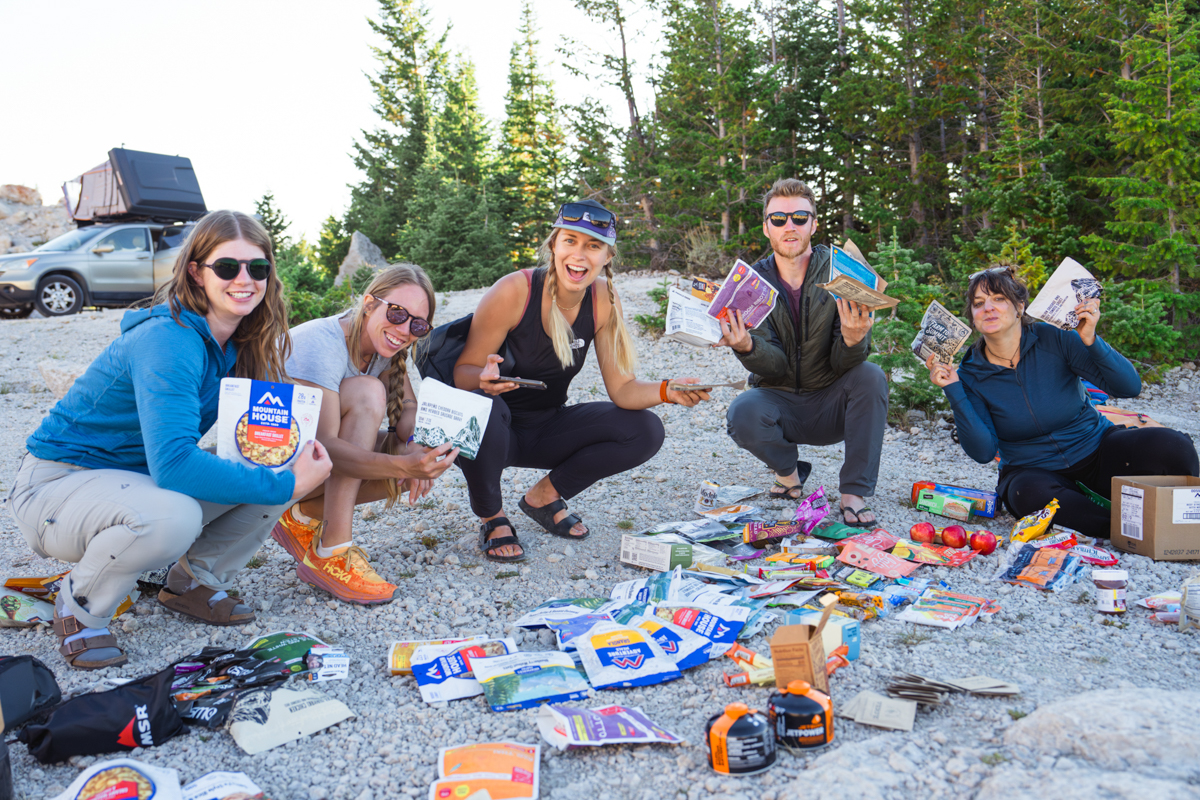
Backpacking food is a difficult gear item to rank because taste is highly individualized. Some of us love high-sodium meals in the backcountry, while others crave all-natural ingredients. Some prioritize flavor and nutrition, while others look for calorie-dense meals that pack down small. Our rankings above take all of these factors into consideration: price, weight, flavor, ingredients, packaging, variety of menu, and more. But because we’re all looking for something different to eat, you simply might not agree with our numbering. That’s okay. Using the chart above, you can hone in on what matters most to you and compare the specs for all of the meals we included.
.jpg)
One way we’ve categorized the meals in this article is by cooking method: pouch or pot. Many backcountry travelers opt for “pouch” meals like Backpacker's Pantry or Good To-Go due to their ease of preparation and cleanup. You simply add boiling water to the pouch and let it sit for the specified amount of time, and no bowl or pot is required (nor is cleaning said bowl or pot after your meal). Notably, the lack of cleanup also reduces impact on fragile wilderness environments. On the other hand, “pot” meals—like those from RightOnTrek—require that you pour the dried contents into a pot, add water, and most often heat the meal over a flame. Sometimes instructions will require that you simmer the meal for up to 10 minutes (requiring a backpacking stove with good flame control). Of course, when the meal is finished, you have to clean the pot and pack it away for your next day on the trail.
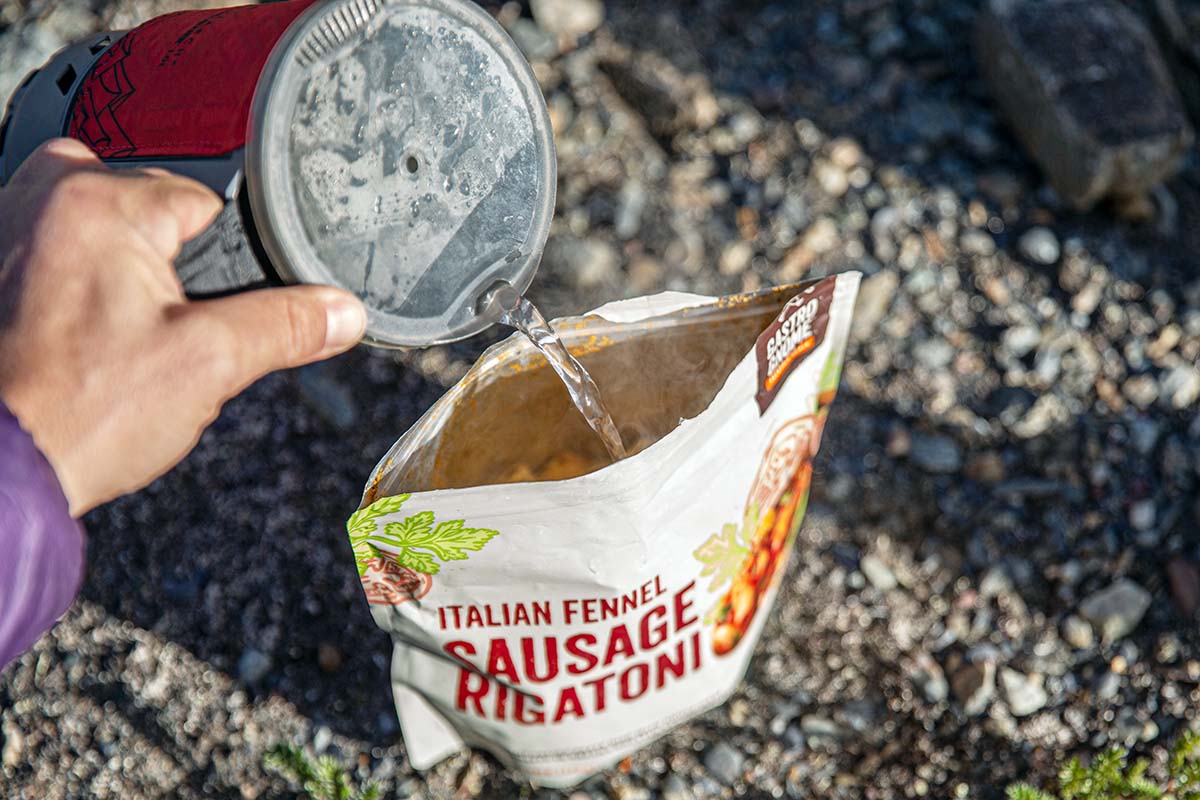
Depending on the cooking method, the meals in this article take anywhere from 5 to 20 minutes to cook. For pouch meals such as those from Heather's Choice, you simply let the food sit in hot water for 15 to 20 minutes—no need to tend to it. Pitch the tent, collect more water, sit down and work on a crossword with your hiking partner—20 minutes will fly by. We personally don’t mind this waiting time and find the distinction between 8 and 20 minutes almost inconsequential (although this doesn’t mean that we don’t dig in a little early and eat crunchy noodles on the rare occasion). On the other hand, pot meals like those from RightOnTrek require that you stir the meal occasionally as it simmers, meaning you’ll need to be beside your backpacking stove for the duration of the cook time.
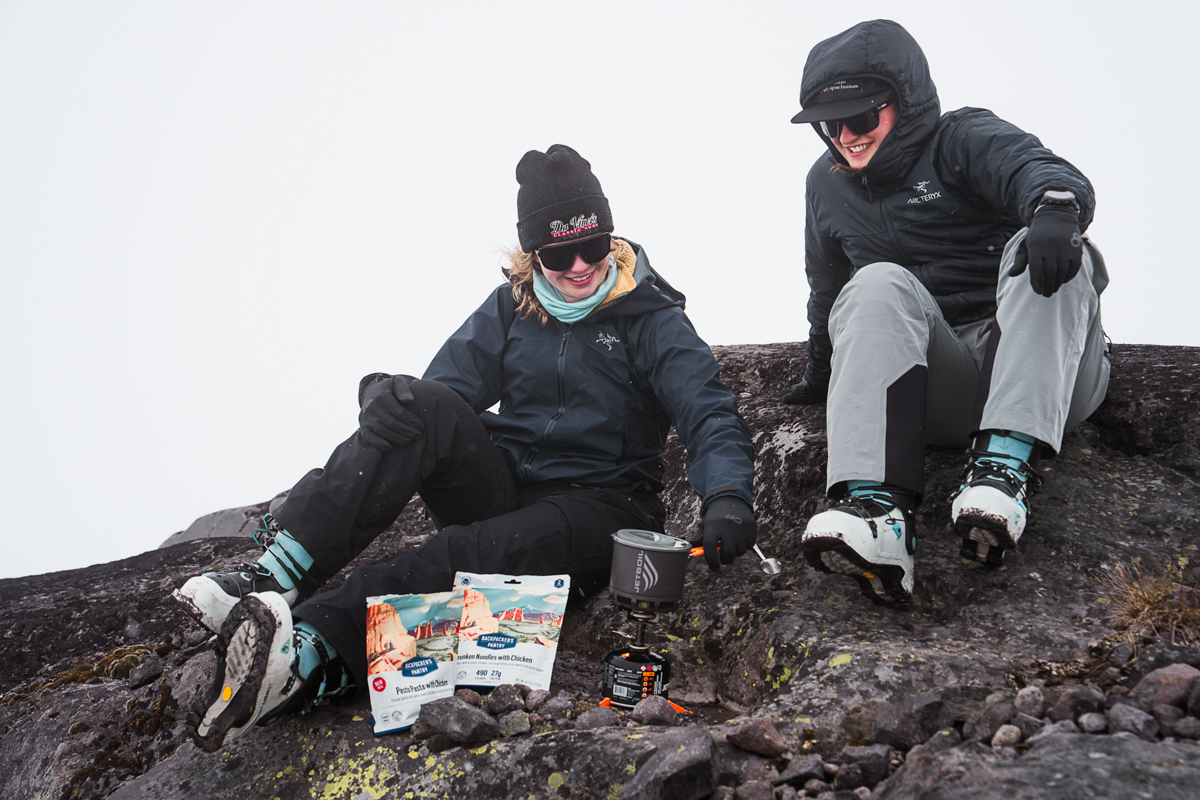
We’re not here to provide an equation for calories burned based on mileage, elevation gain, pack weight, altitude, body weight, and metabolism, or give our opinion on whether or not a backpacking trip is a prime time to start a diet. We’ll leave that to the experts and to your own personal discretion. But we will say if you want to stay strong and energetic during outdoor activities, you’ll generally need to eat more than you would on a normal day at home. It’s quite simple: for every calorie out, you want to put at least one in. With that in mind, calories are your friends in the backcountry and the numbering on nutritional labels deserves your attention.
When you find the calorie number on the back of your food pouch, take note that it denotes the number of calories in a single serving. This is not necessarily the number of calories for the whole pouch: some are single serving, others are double, and some are even made to serve four people. And keep in mind that companies vary significantly on serving size. A standard Gastro Gnome meal, for example, can contain up to 850 calories per serving, while an average Mountain House meal serving size is 290 calories. Speaking from personal experience, on a serious backpacking trip we find that we need a double serving from most brands to satiate our hunger at dinnertime. For this reason, we recommend that you pay more attention to the calorie count than the serving size, and don’t be shy about eating far more than one serving. Not often does food go to waste in the backcountry…
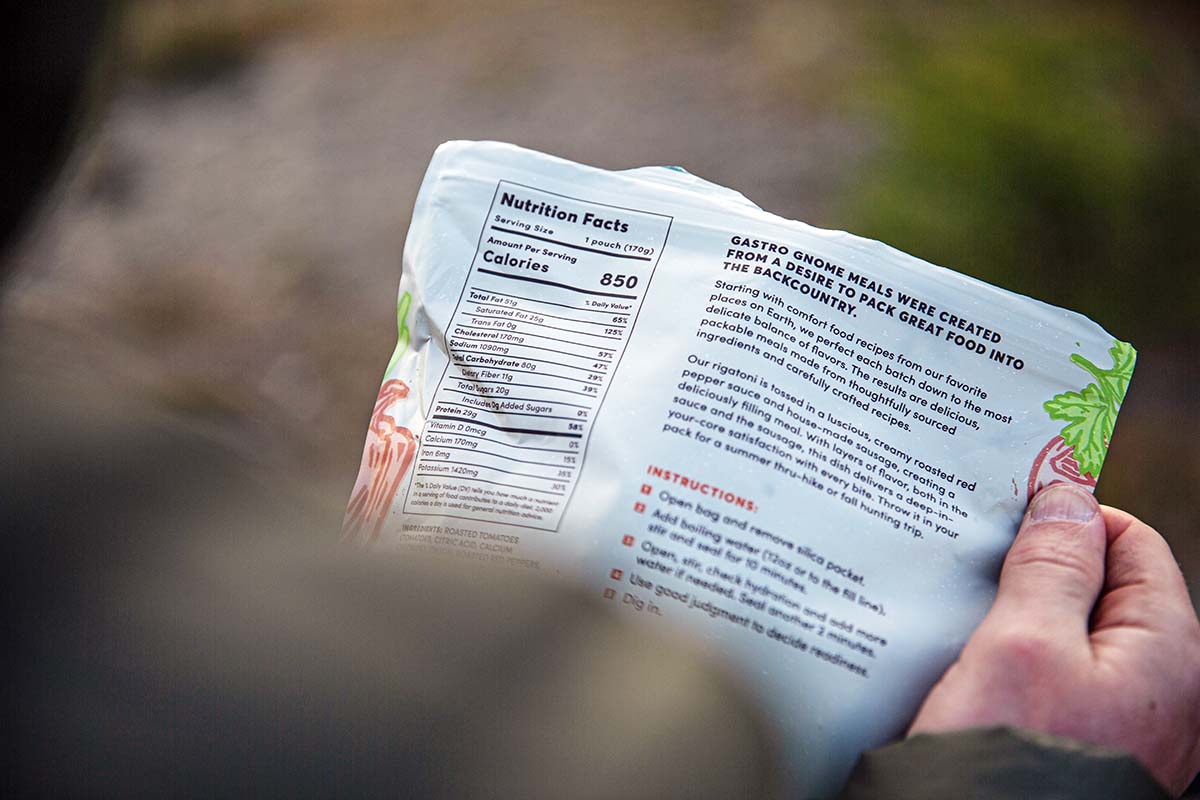
Whether you’re a thru-hiker who saws off half your toothbrush and tears completed pages out of your book, or a weekend warrior who enjoys creature comforts on the trail, all backcountry travelers share some level of concern about weight. Because food is such a large portion of your load, the goal is to maximize taste and calories for the least number of ounces. For this, our “calories per ounce” spec can be your guide.
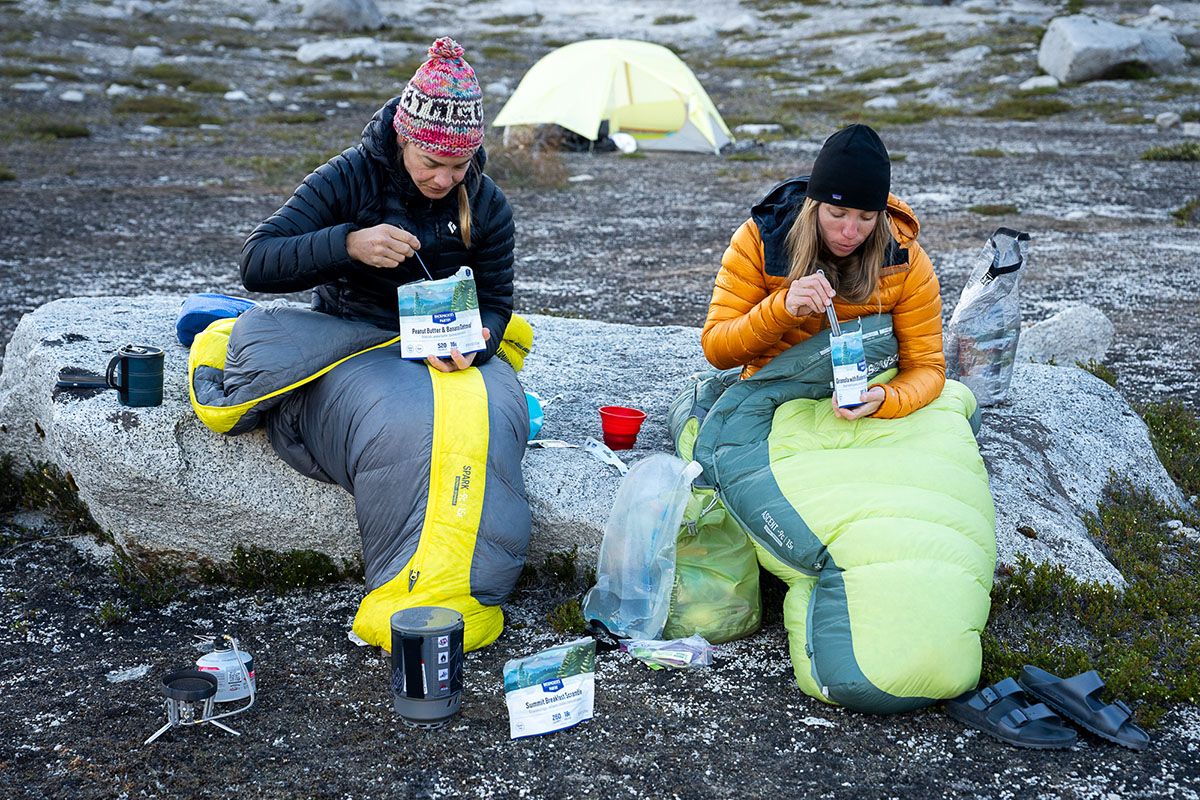
To come up with this number, we divided the number of calories by the weight of the packaged meal. For example, Stowaway Gourmet's meals average 620 calories per 4.07 ounce serving: Divide 620 by 4.07 and you get 152, the calories per ounce. You’ll want to aim for around 100 calories per ounce, and the larger this number, the better. To illustrate, an average Farm to Summit meal contains only 118 calories per ounce, whereas Peak Refuel meals contain 163 calories per ounce. So, if you’re hoping to consume a 800-calorie dinner, Peak Refuel will weigh 5.8 ounces, and your Farm to Summit dinner 6.3 ounces. Add it all up over a week-long trip, and with heavier food you’re either carrying a lot more or dealing with an empty stomach.
.jpg)
All-Natural Options
Much to the delight of the health-conscious, there are a growing number of all-natural (meaning real food: no artificial flavors, additives, or preservatives) backcountry meal options. In fact, the majority of brands here—including Good To-Go, Gastro Gnome, Pinnacle Foods Co, Heather's Choice, Next Mile Meals, and Firepot—pride themselves on using only natural ingredients. Others, such as AlpineAire, have many all-natural options and strive to use only real food ingredients whenever possible.
Preservatives are one of the most common unnatural offenders in backcountry meals, added to increase the shelf life and guard food from being spoiled by microorganisms such as mold, bacteria, and yeast. Although some preservatives are natural (salt, garlic, spices), many are manufactured chemicals. Mountain House’s 30-year guarantee is an extreme example, requiring a good deal of unnatural ingredients and a heckuva lot of sodium for such a long shelf life. On the other hand, if you can read an ingredient label and know where to find each entry in the grocery store, chances are they’re natural.
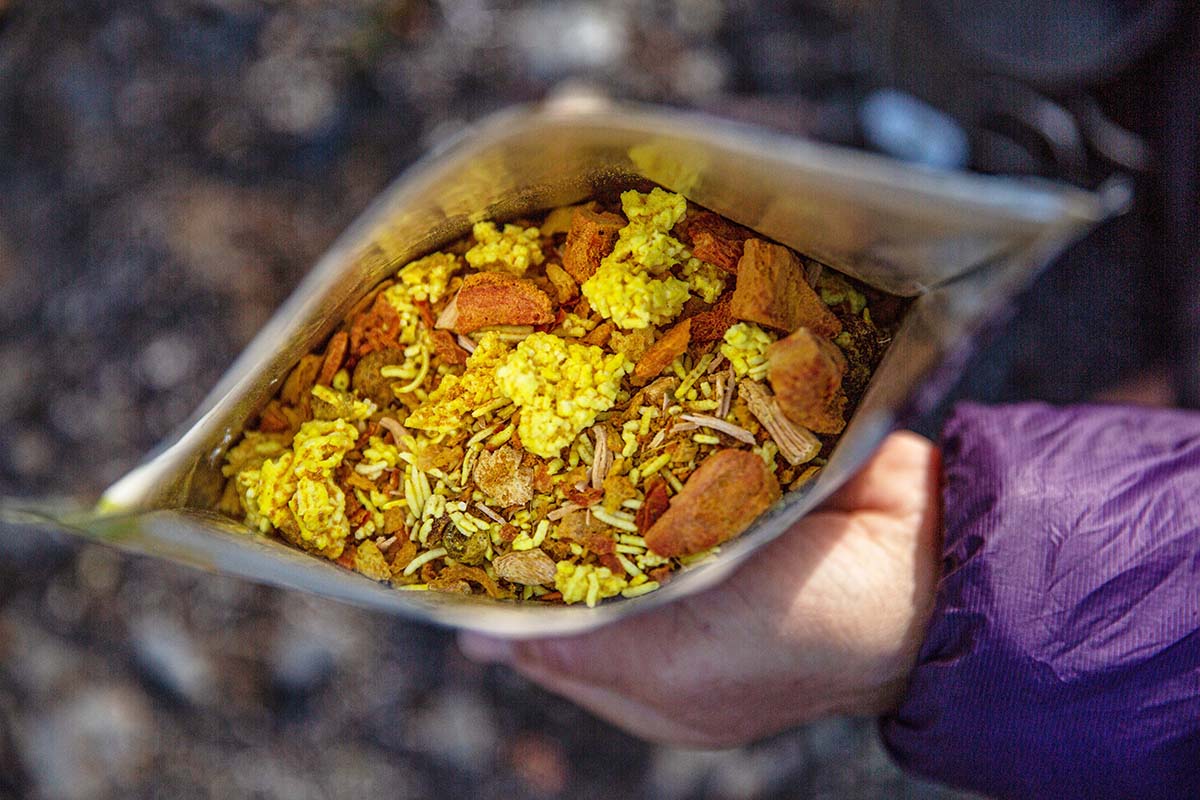
Special Diets
Most backcountry food brands have adapted their menus to accommodate the growing vegan, vegetarian, paleo, ketogenic, gluten-free, dairy-free, soy-free (etc., etc.) markets. Generally, it shouldn’t be difficult to find meals that suit your dietary needs. Good To-Go pouches, for example, are fully gluten-free. Farm to Summit only sells vegetarian, vegan, and gluten-free cuisine, Heather’s Choice only uses ethically sourced meats, and Next Mile Meals appeals to the ketogenic crowd. Finally, AlpineAire offers a filter feature on their website that allows users to find meals with specific ingredients or special diet options. To help highlight the possibilities, we’ve included the “special diets” spec in our table above.
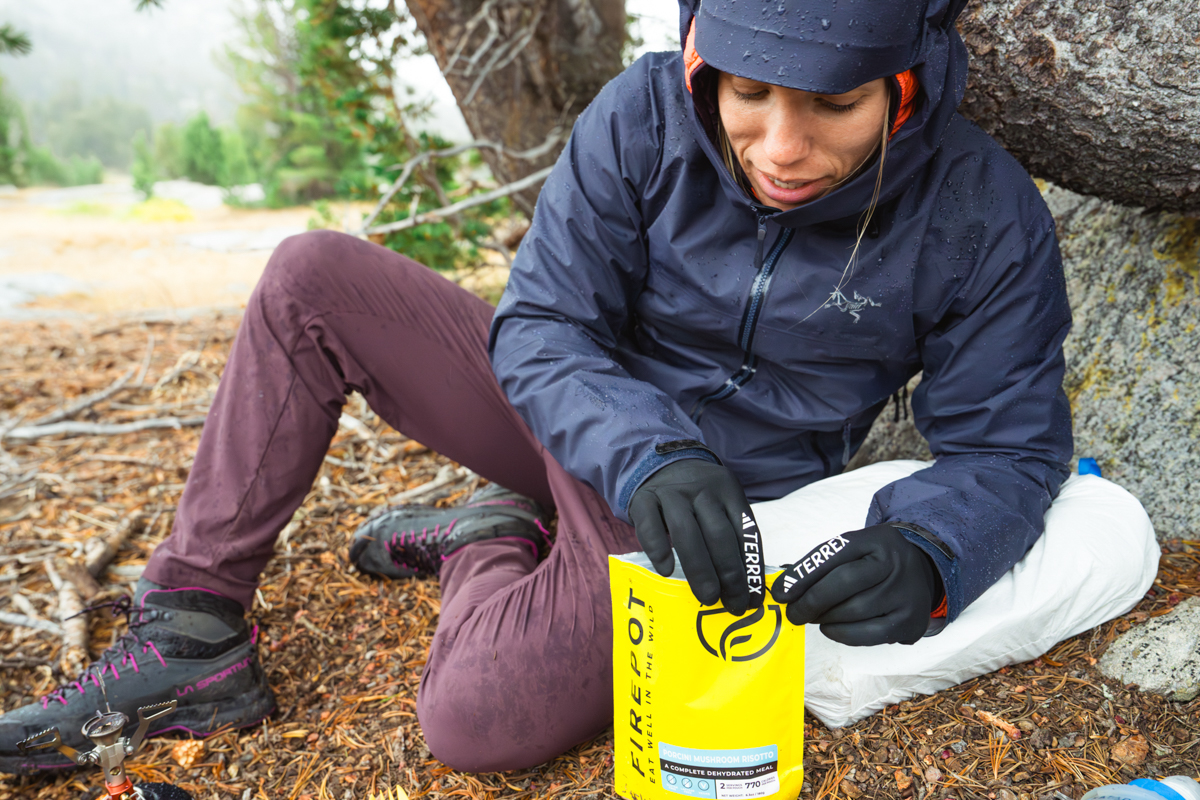
Sodium
The American Heart Association recommends that adults limit their sodium intake to 2,300 mg per day, and ideally not exceeding 1,500 mg. However, most healthy and active individuals who spend much of the day sweating in the hot sun will need—and thus crave—high-sodium foods to replenish what is lost. With an average of 400 to 800 mg of sodium per serving (and remember, you’re probably eating more than one serving), it’s no secret that most backcountry meals are high in sodium (Pinnacle Foods' meals are among the worst offenders, with up to 1,570 mg/serving). If you’re looking to keep your sodium intake down, pay special attention to the nutritional facts (we see a great deal of variation from meal to meal). Additionally, meals from Good To-Go, Farm to Summit, and Nomad Nutrition tend to be lower in sodium than most.
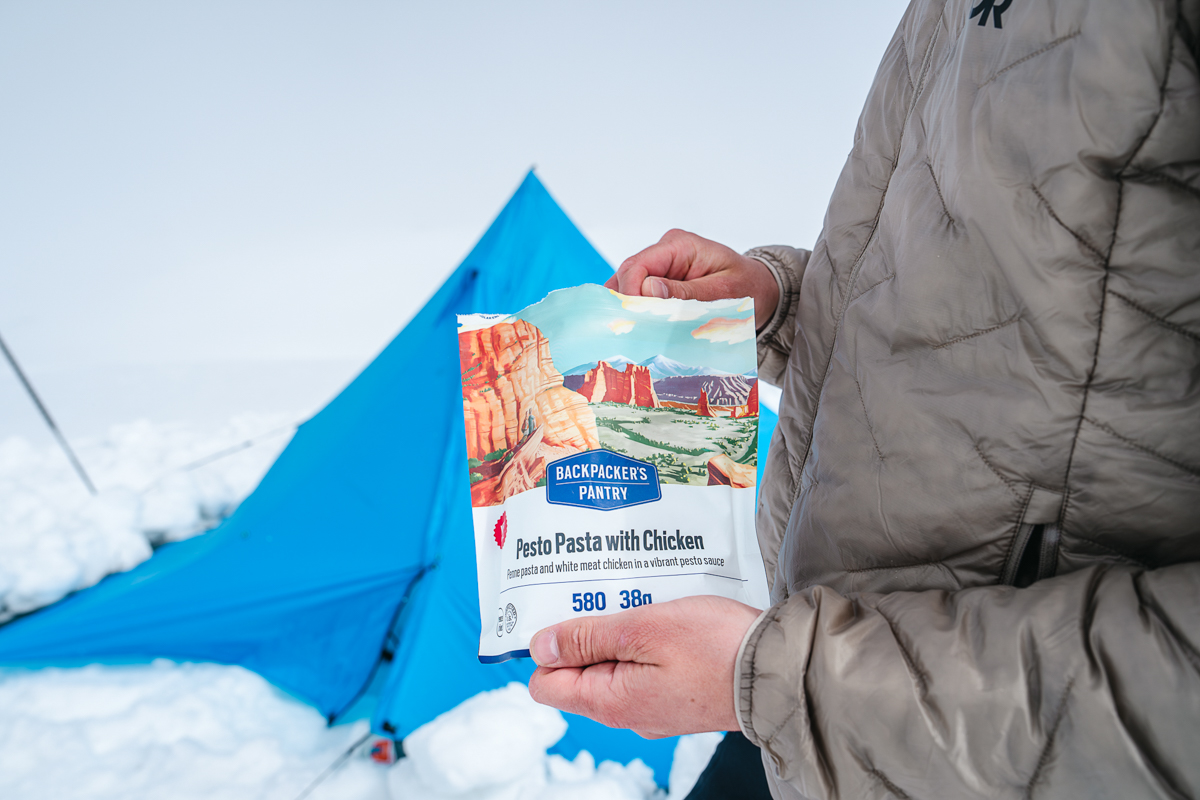
Dehydrating and freeze-drying are two distinct methods of food preservation. In the freeze-drying process, food is placed in below-freezing temperatures and gradually warmed, moving water in the food from a solid to gaseous state. The dehydration process, on the other hand, exposes food to hot and dry air over several hours (smoking and sun-drying are also methods of dehydrating). In the end, the freeze-drying process removes 98-99% of moisture from food, while dehydrating removes 95%. Both processes result in dried food that needs to be soaked in water to regain its size, texture, and edibility, but with noticeably different characteristics.
Due to its lower water content, freeze-dried food is lighter and has a longer shelf life than dehydrated food. Surprisingly, it also rehydrates almost twice as quickly—freeze-dried Mountain House meals cook in 9 minutes versus the 20 minutes required for dehydrated Good To-Go meals. On the other hand, dehydrated ingredients shrink more (think plum to prune), meaning they’ll take up less room in your pack. They’re also known to keep their original texture better than freeze-dried ingredients. In terms of taste, the two methods go head to head.
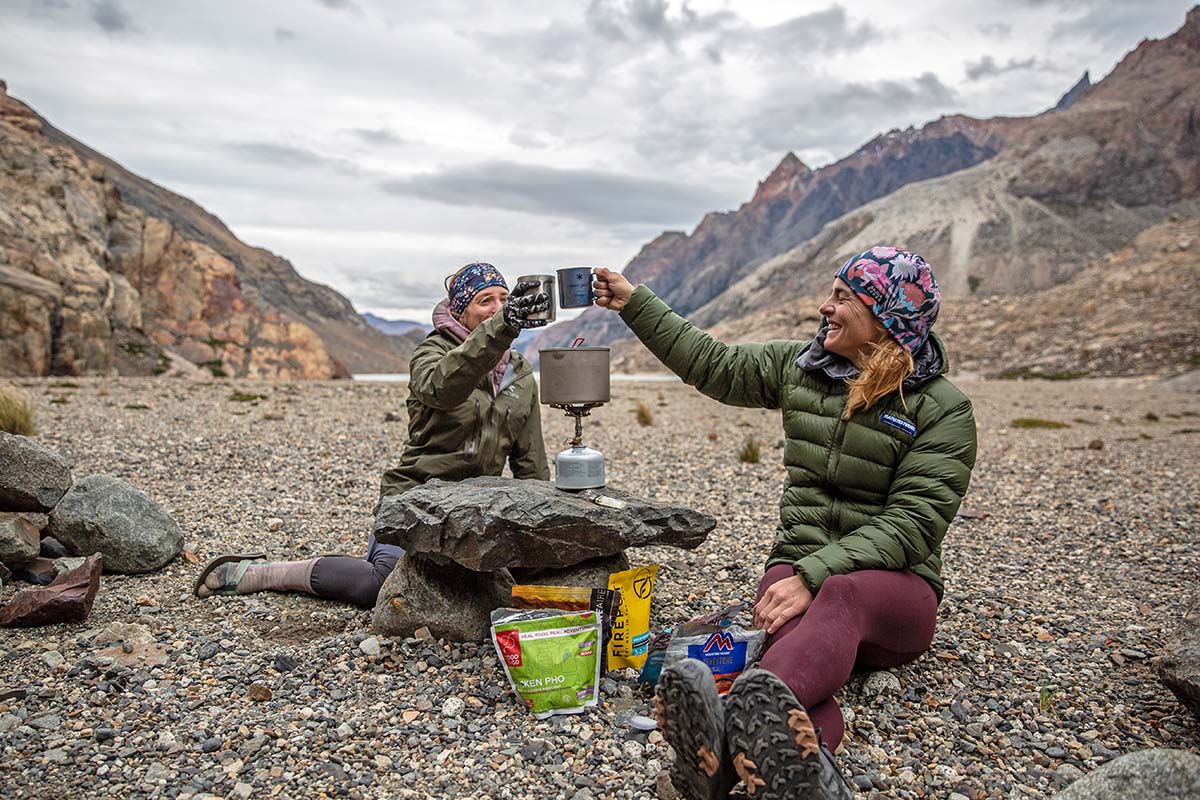
While some brands (like Good To-Go and Mountain House) use either exclusively dehydrated or freeze-dried ingredients, most use both. Manufacturers use discretion when choosing which process works best for each ingredient, weighing the pros and cons of flavor, size, and price. In short, the freeze-dried versus dehydrated debate matters little to the everyday consumer. The companies do the legwork to find the best way to dry food, so we can sit back after a long day on the trail and enjoy the outcome.
To complete your meal kit, most backpackers will want to add breakfast and coffee (and snacks) to their shopping list as well. For many of us, breakfast is a lighter, quicker, and simpler meal than dinner, and oftentimes bulk oatmeal or a bar with some dried fruit will suffice. But for those who prefer a more substantial or elaborate start to their day, there are myriad options to choose from. Most brands featured above offer a lineup of breakfasts, too, ranging from savory options like the Mountain House Breakfast Skillet to sweet treats like Backpacker’s Pantry Granola with Blueberries, Almonds, and Milk. Packaged backcountry breakfasts usually start as low as $7 and are available in one- and two-serving options.
.jpg)
If you’re anything like us, breakfast just isn’t complete without a hot cup of coffee. You have a lot of options when it comes to a backcountry brew, ranging from lightweight and portable pour-over setups to disposable drip coffee kits from brands like Kuju. The most lightweight solution is instant coffee, which we’ve found to be perfectly sufficient for our morning cup of joe. A number of options are available, from Trader Joe’s to the ubiquitous Starbucks Via. Our personal favorite is Alpine Start, a small startup out of Boulder that specializes in making fantastic coffee for the trail. Alpine Start can be made with hot or cold water and is good enough that we’ve even been caught drinking it at home a time or two.
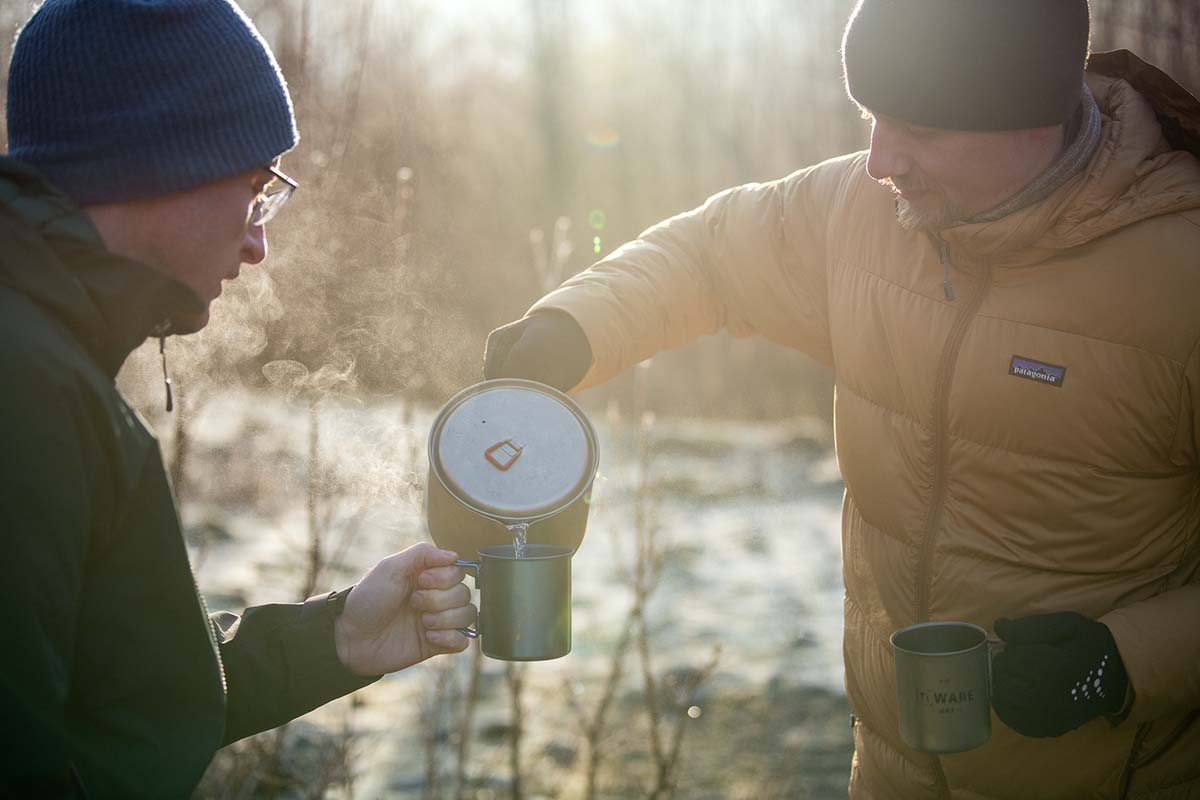
One commonality among most of the brands featured above is the growing commitment to sustainability. Many prioritize the use of real and locally sourced ingredients, including Farm to Summit, which utilizes "up-cycled" or imperfect fruits and veggies that would otherwise be disposed of. Firepot also sources their ingredients from local suppliers and butchers who uphold the highest standards of animal welfare. Compostable packaging is on the rise as well, with brands such as Firepot and Pinnacle Foods offering biodegradable meal pouches (of course, this doesn't mean your waste should be left on the mountain). Larger companies, like Backpacker's Pantry, are also turning to more sustainable manufacturing—their facility in Boulder, Colorado, is carbon-neutral and offsets 100% of their energy use with solar power. No matter the approach, we’re excited to see more environmentally friendly practices trickling down into the backpacking meal market.
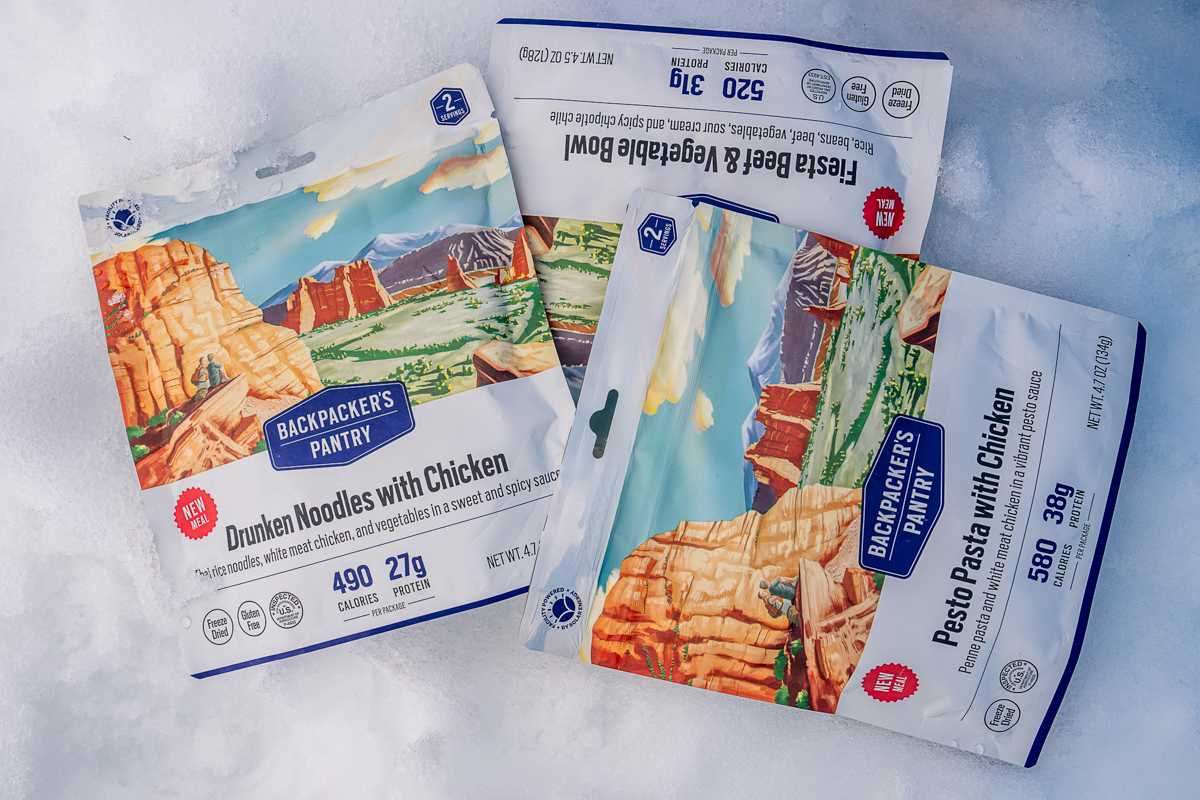
The pouch meals predominantly featured in this article might be your most convenient option for backcountry dining, but they aren’t the only way to eat dehydrated or freeze-dried ingredients. Maybe you’re pinching your pennies, cooking for the masses, or just enjoy channeling your inner chef in the wilderness. You can find bulk dehydrated and freeze-dried ingredients from a number of online vendors, including Harmony House Foods, High Quality Organics, and Packit Gourmet. And recipes aren’t hard to come by: With a simple Google search, you can find tasty meal ideas like this Beef and Barley Stew.
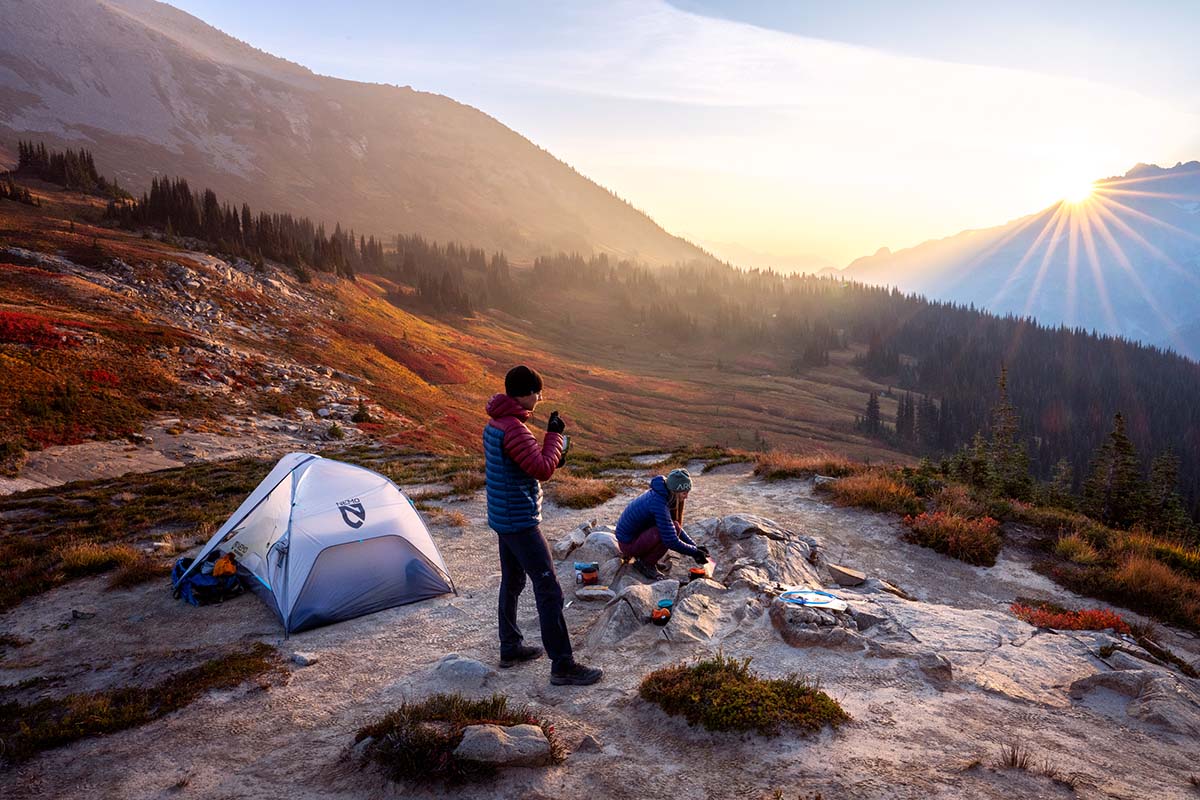
You’re paying a pretty penny for convenience when you opt for the prepackaged meals above. A one-stop shop at your local gear store (or even online) can save you hours in meal planning for your next backcountry trip. That said, if you’re inclined to DIY, you can save yourself a great deal of money by dehydrating your own meals. You can even do so in your oven, although most will find an actual food dehydrator works better. You’ll usually want to cook your ingredients before dehydrating (a raw onion, dehydrated and then rehydrated, is still a raw onion). Many online guides provide the temperature and time specifications for different types of food. And take note: If you’re dehydrating food and planning to store it for months or years, make sure that it’s properly dehydrated and fully sealed.
.jpg)
The prepackaged meals and dehydrated ingredients we’ve mentioned above are the most convenient and lightest way to eat in the backcountry. That said, there really are no rules here and plenty of “real” options. Macaroni and cheese, couscous and canned chicken, a frozen burrito bought the morning of, Tasty Bites, even fresh vegetables—the sky is the limit. For some, food preparation (rather than simply pouring water into a pouch and waiting 10 minutes) can even be a fun way to relax at the end of the day. There’s no denying that dehydrated meals are the easiest, but don’t let this article lull you into thinking that they are the only way to go. Be creative and have fun out there.
.jpg)
Many of the meals in this article rehydrate in their pouch, making them popular options because they only require adding boiling water. For these meals, we recommend bringing an all-in-one stove system such as the Jetboil Flash. It’s compact, boils water quickly, and is reasonably priced. For “pot” meals, you’ll probably want a more traditional stove with a simmering function, like the MSR PocketRocket 2 or Dragonfly. For more information including our top picks, check out our article on the best backpacking stoves. If you want to leave the stove behind, consider bringing pre-cooked dinners (like MREs or Omeals) or meals that can be hydrated with cold, filtered water.
.jpg)
The amount of fuel you’ll need on your next backpacking adventure depends largely on whether you’re eating “pouch” or “pot” meals. For pouch meals, you simply boil the water, turn off the stove, and pour the water into the pouch. For pot meals, on the other hand, you might need to boil or simmer the food for up to 10 minutes. If you’re out for a week, this cook time can certainly add up to a lot more fuel. Keep in mind that altitude, temperature, and wind are also factors in how much fuel you consume.
For meals that require cooking over a flame, take your pick from a wide assortment of pots and pans, from ultra-lightweight titanium to more durable stainless steel or aluminum. When cooking for more than one, we recommend bringing a lightweight bowl or mug/bowl combo along. If you’re traveling solo, you can save weight and just eat straight from the pot. Finally, keep in mind you might want a second pot or kettle to use exclusively for boiling water for hot drinks.
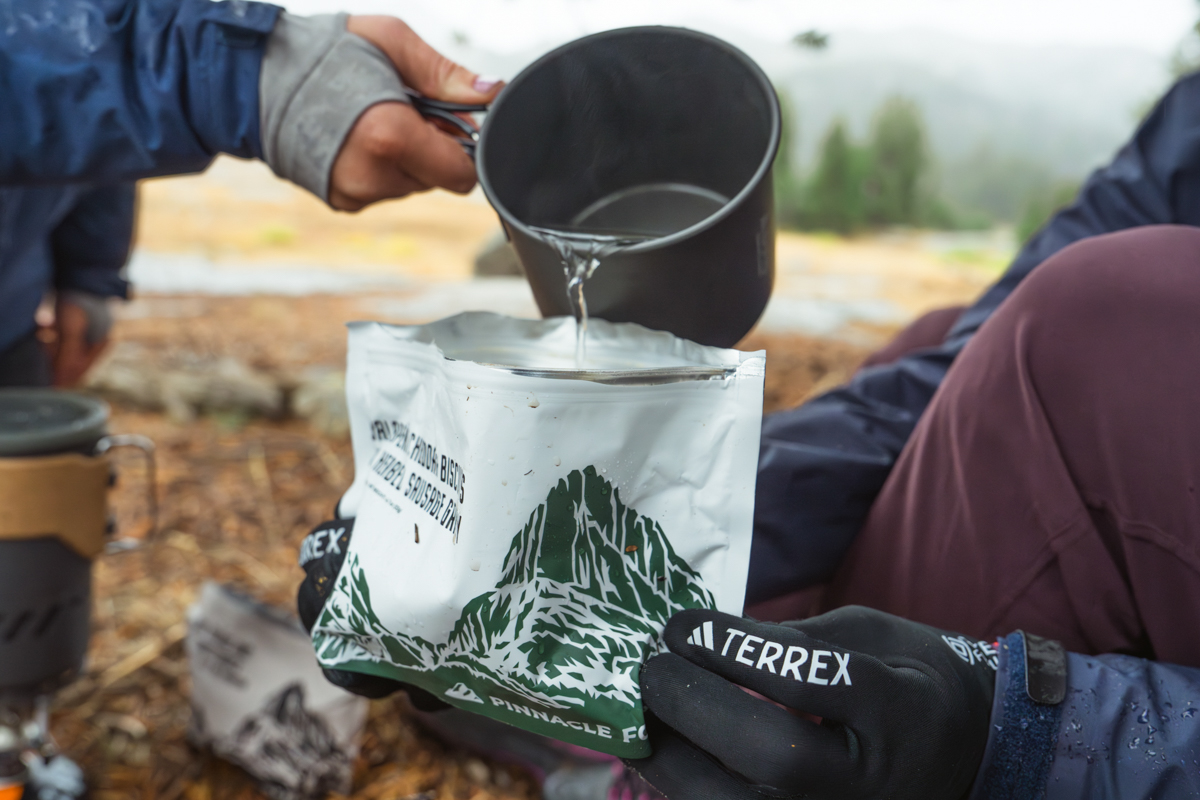
A meal’s shelf life denotes the amount of time that it retains its flavor, nutrition, and edibility. Looking at the brands above, the shelf lives vary from 1 to 30 years, depending on the preservation method (dehydration, freeze-drying, or pre-cooking) and type/amount of preservatives used. This information is easy to find on the packaging or manufacturer website. To guarantee their shelf life, backcountry meals should be stored fully sealed in a cool and dry environment (no refrigeration needed).
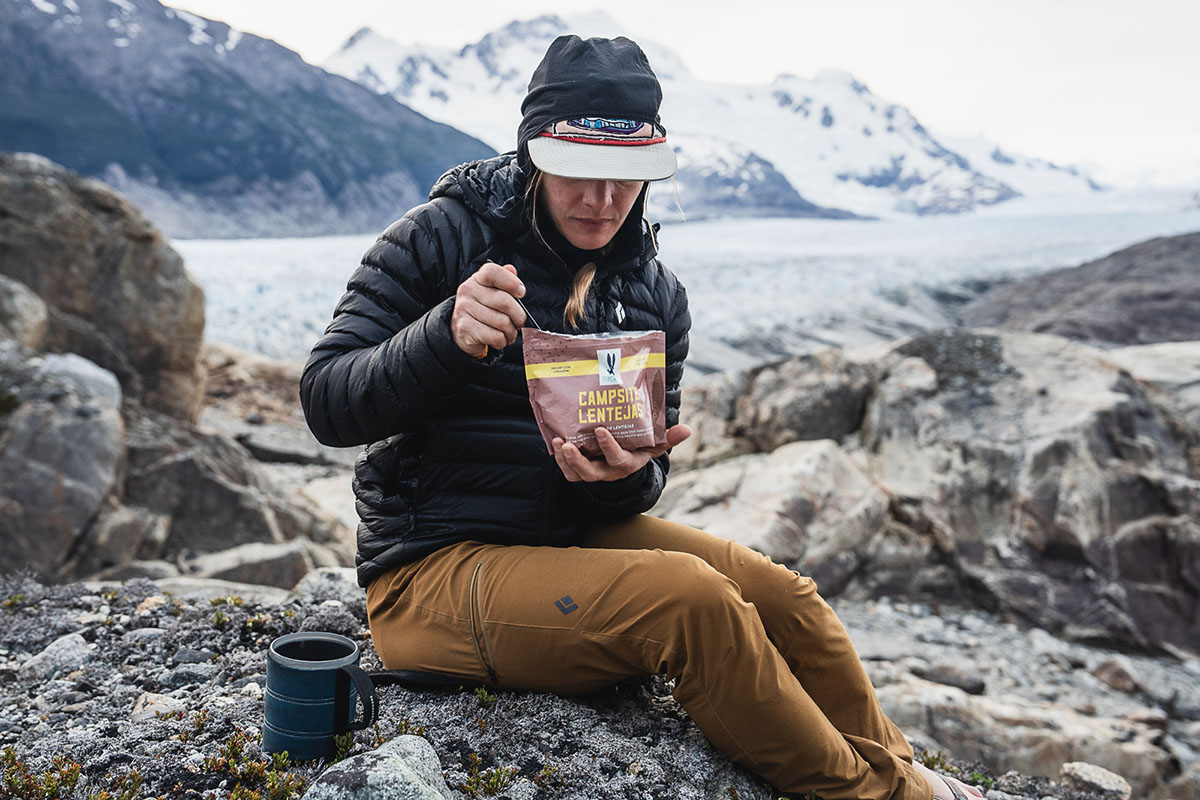
Most backcountry enthusiasts are buying for their next adventure, meaning that shelf life shouldn’t be a concern for most. But backpacking food, as it turns out, is also ideal for emergency preparedness—it takes up less space on your shelves than canned goods (the benefit of that calorie-to-weight ratio), lasts for a long time, and is easy to prepare. For stocking up in case of an emergency (or if you’re buying in bulk for trips well into the future), the shelf life is a specification worth considering. And if food storage is your main intent, we do recommend buying in bulk. Companies like Mountain House offer their meals in cans and even buckets, which will take up significantly less space and save on both packaging and money.
Back to Our Top Backpacking Meals Picks Back to Our Backpacking Meals Comparison Table